Ages 10-12 Overview (Schedule, Recipes, etc..)
OLD TESTAMENT
AGES 10-12
This file is provided as a resource for Church School directors. Feel free to plug in your own dates and your own teachers.
Teachers:
Schedule of Classes:
|
Date |
Teacher |
Lesson/Activity |
Special Notes |
|
September 13 20 27 |
|
Creation Adam & Eve/The Fall Noah |
|
|
October 3 4 11 17 18 25 |
|
Movie Night: Noah Tower of Babel Abraham Movie Night: Abraham Isaac Jacob |
Outdoors if possible
Social Hall after Vespers
|
|
November 1 8 15 21 22 29 |
|
Joseph #1 Joseph #2 Moses #1 Movie Night: Moses Moses #2 Balaam |
All Saint’s Party
Social Hall after Vespers Memory: 10 Commandments |
|
December 5 6 13 20 27 |
|
St. Nicholas Party Joshua Judges/Gideon Nativity Pageant Job |
Parish Wide
Social Hall and Nsg. Home
|
|
January 3 10 17 24 30 31 |
|
Ruth Samuel/Hannah Saul David/Goliath/Psalms Movie Night: David David |
3 Kings Party following
Memory work: Psalm 22 Social Hall after Vespers
|
|
February 7 14 21 27 28 |
|
Solomon Proverbs/Song of Songs Elijah Movie Night: Elijah Elisha |
Pack School Kits
Social Hall after Vespers |
|
March 7 14 21 28 |
|
Jonah Isaiah Jeremiah Ezekiel |
|
|
April 4 5 11 18 25 |
|
PASCHA Bright Monday Egg Hunt 3 Young Men in Fire Tobit Daniel |
No Class After Liturgy
Pack Health Kits
|
|
May 1 2 9 16 23 30 |
|
Movie Night: Esther Esther Minor Prophets No lesson: Camping Trip Minor Prophets Ezra/Nehemiah |
Social Hall after Vespers
Memory Work: Books of O.T.
Book Collection |
|
June 6 12 13 |
|
Maccabees Dress Rehearsal Closing exercises/play |
Book Collection Social Hall after Vespers Social Hall and Nursing Home |
Classroom supplies: Each class is supplied with the following items:
Paper plates, small and large Scissors Stapler/Staples
Paper, plain and construction Tape and dispenser Paper bags
Glue or glue sticks Crayons and/or markers
Popsicle sticks Chenille (colored pipe cleaners)
If you use the last of something, please either replace it or let me know so I can replace it. If you need special craft supplies for your lesson, submit the receipt to me for reimbursement. Each child should have his own Bible and should either leave it on the shelf or bring it each week. Note that if you are using the Orthodox Study Bible (perhaps a bit too difficult for these readers), the Scripture references are different from those of the Protestant or Roman Catholic Bible. References in the curriculum are listed with both the Orthodox Study Bible books (from the Septuagint) and the Protestant Bible books. These will only affect the books of I and II Samuel, now called I and II Kingdoms, and I and II Kings, now called 3 and 4 Kingdoms. There are also maps of the holy land and of the temple.
Teaching Schedule: We all know that there will be last-minute needs; trade with someone if you cannot teach on your assigned day and let the director know!
Insurance: Each of us must “apply” each year for our volunteer position of teacher. Please be sure not to send small children to the bathroom unattended and accompany your charges back to the Social Hall after class.
Opening Exercises: The Church School director will supervise this time, or delegate it when she is absent. Church School children and teachers are dismissed first from Liturgy; children come straight across for snack during opening exercises. These are an integral part of the curriculum – reviewing material from previous weeks, presenting additional Old Testament characters, rehearsing plays, hearing memory work, and playing quiz games.
Curriculum: With each lesson, there is a suggested craft and learning game, in addition to the reading material and the discussion questions. While it would be nice to think the students would read the material ahead of time, it never happens! So, you’ll have to either read it to them or, if they’re good readers, read it aloud in class.
Icons: Each lesson is now illustrated with an icon, gleaned from non-copyrighted websites on the Internet. Feel free to enlarge these and use to amplify your lesson.
Movie Nights and Parties: We will have pizza after vespers on Saturday night while showing a small children’s movie. Older children should bring a sleeping bag for a lock-in with “feature” presentation; we must have at least 2 adults at each overnight. We’ll leave it up to the parents to decide whether their child is old enough to spend the night or should go home after the “kiddie” movie.
Hand-Outs: You can use the coloring pages and puzzles from the Parents' Guide for hand outs. These should be sent home with the children to reinforce the lesson through the week.
RECIPES
CLAYS PAINTS
SALT DOUGH FINGER PAINT (4 WAYS)
2 cups flour Use pudding with food coloring!
1 cup salt Mix liquid starch and food coloring.
about 1 cup water Mix 3 T sugar, ½ cup cornstarch, and
food coloring 2 cups cold water. Cook over
bath oil, vegetable oil, peppermint oil low heat, stirring, till thick.
Mix flour and salt. Add water Pour into muffin tin. Add
slowly and mix with your fingers until food coloring to each cup.
it makes dough. Knead in a few drops
food coloring and a splotch of oil (if SAND PAINT
desired). Store in air-tight container. Add dry tempera paint to corn meal.
Sprinkle over areas “painted” with thinned white glue
SELF-HARDENING CLAY
1 cup sand for sand effect. Shake off excess.
½ cup cornstarch
1 tsp powdered alum PASTES
¾ cup hot water PRIMARY PASTE
Food coloring if desired Mix ½ cup water and 1 cup flour
Mix sand, cornstarch and alum in a bowl. Spoon into a jar
in large pot. Add hot water and stir or squeeze bottle to store.
vigorously. Add food coloring if
desired. Cook over medium heat PAPIER MACHE PASTE
until thick, stirring constantly. 3 cups water
After cooling, store in airtight container. 1 ½ cups flour
Mix flour with cold water until lumps are gone.
SAWDUST CLAY
2 cups fine sawdust Dip pieces of newsprint in paste and mold around
1 cup flour surface to be shaped. Air dry.
Water
Mix sawdust and flour in bowl
or bucket. Add a little water at a time,
stirring till it is stiff but pliable. Knead
till it’s elastic and easy to shape. Store
in airtight container. Air dry.
CORNSTARCH DOUGH
2 cups cornstarch
4 cups baking soda
2 ½ cups water
Mix cornstarch and soda in large
pot. Add water. Cook, stirring, over medium
heat until thick like mashed potatoes. After
cool, knead on wax paper for 5 minutes. Store
in an airtight container. Air dry.
MAP of Old Testament and Modern Times:
The Creation
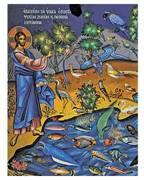
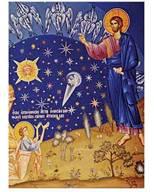 THE CREATION
THE CREATION
Objectives:
- Children should know that God created the world.
- Children should be able to tell the story of Creation and what was created on which day.
Possible lesson plan:
- Open with prayer.
- Scripture Reference: Genesis 1 and 2.
- Learning Game: Missing Parts – Give each child a card with a number between 1 and 6 on it. Around the room, hide cards with the names of things God created on them, several for each day. The students should conduct a search for their “missing parts” – the things that were created on their day. Then have each student present his findings to the class. Were they right?
Day 1: light, darkness, day, night
Day 2: waters heaven,
Day 3: land, seas, trees, flowers
Day 4: sun, moon, stars
Day 5: fish, birds, sea monsters, sharks, whales
Day 6: cows, sheep, lions, elephants, toads, snakes, man
- Discussion: Creation is an unpopular belief today and children as young as these are subjected to the assumption that the theory of evolution is a fact. The Bible is very clear – Who created everything? How did life begin?
- Environmentalism however is very popular today; everyone worries about the rain forests. This is the first church school lesson of the liturgical year; the first day of the new year is designated as environmental awareness day. Whom did God entrust with His creation? What responsibility do we have towards all living things? What are some ways we can individually or as a family or as a church show our responsibility for God’s creation?
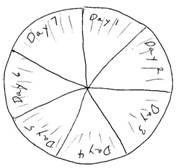 Make a Creation Mural for the whole class to enjoy on your bulletin board. Take 7 pieces of construction paper. Assign one day of Creation to each student (or work in pairs if there are more than 7 students) and have them draw or paint the happenings of that day. Put them up, surrounded by bits of cotton to look like clouds, and with appropriate lettering.
Make a Creation Mural for the whole class to enjoy on your bulletin board. Take 7 pieces of construction paper. Assign one day of Creation to each student (or work in pairs if there are more than 7 students) and have them draw or paint the happenings of that day. Put them up, surrounded by bits of cotton to look like clouds, and with appropriate lettering.
- Make a “Creation Wheel”: Give each student a paper plate divided into seven sections labeled “Day 1”, “Day 2”, etc. Have magazines available (Pat has lots
if you ask) and cut out pictures appropriate for that day, or draw an appropriate drawing. Glue in the appropriate space. Write in “And God Rested” on Day 7.
Close with prayer.
Adam and Eve and the Fall
ADAM AND EVE AND THE FALL
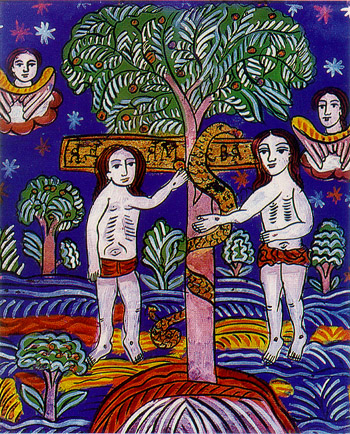 Objectives:
Objectives:
1. Children should be identify Adam and Eve, the Holy Forefathers.
2. Children should be able to tell the story of the Fall.
3. Children should identify Satan, the snake.
Possible Lesson Plan:
1. Open with prayer.
2. Scripture Reference: Genesis 3.
3. Learning Game: Skit – Have the students each take a role in the story: Adam, Eve, Satan, God. The rest can be animals. Have them re-enact the story as they remember it after reading it with you.
4. Discussion: Why did God create people? Why did Adam and Eve sin? Why did God let them? Do we ever disobey our parents? God? Why is it so easy to disobey when we know better? Why do we choose to disobey? What happens when we disobey? What excuses did Adam and Eve make for disobeying God? What excuses do we make?
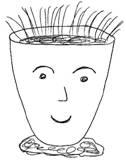 5. Make Egg People: Take 2 L’eggs eggs for each student. These will be Adam and Eve. Give each student 2 hunks of modeling clay for bases. For each, remove the short, fat end of the egg and discard. Press the rounded end of the larger half into the base. Decorate the egg as a face with eyes, nose, mouth, and ears made of felt, beads, paper, etc. Fill eggs with potting soil. Add a scattering of grass seed on the top. Water. Place in sunlight and keep watered and the grass will sprout and become the hair!
5. Make Egg People: Take 2 L’eggs eggs for each student. These will be Adam and Eve. Give each student 2 hunks of modeling clay for bases. For each, remove the short, fat end of the egg and discard. Press the rounded end of the larger half into the base. Decorate the egg as a face with eyes, nose, mouth, and ears made of felt, beads, paper, etc. Fill eggs with potting soil. Add a scattering of grass seed on the top. Water. Place in sunlight and keep watered and the grass will sprout and become the hair!
Alternate craft idea:
- Alternate Craft idea: Tree and Serpent. Cut out trunk from brown construction paper and either use real fall leaves or cut leaves from the patterns or use leaf stickers. Have children glue to blue construction paper and add cotton ball clouds and Easter grass at the bottom. Add lifesaver fruit and a gummy worm serpent. Finally place Adam and Eve figures below the tree. You can either have each child draw a man and a woman OR use the figures from the icon above, enlarge, print, cut out, and glue on.
6. Close with prayer.
Noah
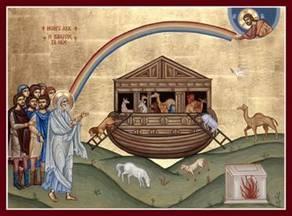 NOAH
NOAH
Objectives:
- Children should be able to tell the story of Noah and the ark.
- Children should identify the Great Flood and its significance.
- Children should know God’s meaning for a rainbow.
Possible Lesson Plan:
- Open with prayer.
- Scripture Reference: Genesis 6:9-8. A bit long but difficult to leave any part out. How big was that ark after all? (about 450 feet: 1 cubit is about 18 inches). How long were they in the boat? (more than a year!) What was the meaning of the rainbow?
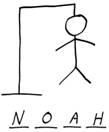 Learning Game: Hangman – Write on pieces of paper words or names important to this story: Noah, dove, rainbow, ark, Shem, Ham, Japheth. Each student in turn can draw a word and put the appropriate number of dashes, one for each letter, on the board. Students guess the letters; if the letter is in the word, the hangman writes it on the appropriate dash mark. If not, he draws the head of the hanged man. With each subsequent guess, he adds trunk, arm, arm, leg, leg. The object is to guess the word before the man is hanged.
Learning Game: Hangman – Write on pieces of paper words or names important to this story: Noah, dove, rainbow, ark, Shem, Ham, Japheth. Each student in turn can draw a word and put the appropriate number of dashes, one for each letter, on the board. Students guess the letters; if the letter is in the word, the hangman writes it on the appropriate dash mark. If not, he draws the head of the hanged man. With each subsequent guess, he adds trunk, arm, arm, leg, leg. The object is to guess the word before the man is hanged.
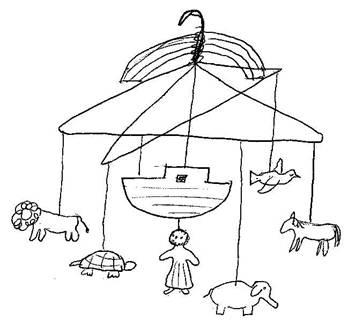 Discussion: How do you think Noah felt building a huge boat in his back yard with all the neighbors laughing at him? Have people ever laughed at you? How did it feel? How did you respond? How did Noah respond?
Discussion: How do you think Noah felt building a huge boat in his back yard with all the neighbors laughing at him? Have people ever laughed at you? How did it feel? How did you respond? How did Noah respond?
- Make a Noah Mobile: Take 2 hangers and cross them as illustrated, securing with duct tape. Have children draw an ark, Noah, and several animals (or color them in a coloring book) Cut out. Punch a hole in each, tie a string, and tie to the mobile. draw a rainbow, cut out, and glue to the hanger crosspieces overtop.
Way too complex and time-consuming? Print the paper model on cardstock, color, cut out, fold the tabs and tape or glue to make the complete ark in one piece:
- Close with prayer.
The Tower of Babel
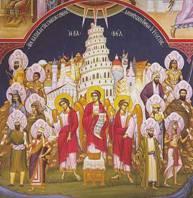 THE TOWER OF BABEL
THE TOWER OF BABEL
Objectives:
- Children should be able to identify the Tower of Babel and tell its story.
- Children should identify the source of the many languages we have today.
Possible Lesson Plan:
- Open with prayer.
- Scripture Reference: Genesis 11:1-8. This one would probably be easy to have each student read a verse going around the circle – short and sweet. Why did the people build the tower? Why did God confuse their languages?
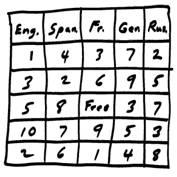
- Learning Game: Language Bingo – Make bingo cards for each student with 5 languages across the top (English, Spanish, French, German, and Russian – or whatever you speak) and numbers between one and ten in the spaces; each card can be different. Now call the names of the numbers in the appropriate language and see if the students have any idea which space to mark!
For reference:
Spanish: uno, dos, tres, cuatro, cinco, seis, siete, ocho, nueve, diez
French: un, deux, trois, quatre, cinq, six, sept, huit, neuf, dix
German: eins, zwei, drei, vier, funf, sechs, sieben, acht, neun, zehn
Russian: adeen,dvah,tree,chetiree,pyaht,shest,syem, vosyem, dyevyet, dyesyet
Use the cards below unless you want to substitute the languages common to your own parish:
- Discussion: Do you speak another language? Many of the children have no idea what it is like to not understand what someone is saying; indeed, travel to a foreign country is one of the only ways to bring this lesson home. But, give it a try. Begin the lesson in another language, or give the instruction for the crafts in another language. Watch the blank stares and discuss their reactions.
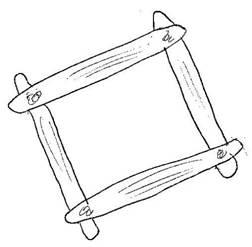
- Make a craft-stick tower:
Begin with 2 sticks. Put glue on
the ends of each, and add 2 more
perpendicularly across. Then put
glue on the ends of these and add
2 more just over the 1st 2. Keep
adding until tower is tall enough.
glue on paper windows, door, etc.
You can even make a flag for the
top saying “Tower of Babel”.
Close with prayer.
Abraham
- .
 ABRAHAM
ABRAHAM
Objectives:
- Children should be able to tell the story of Abraham.
- Children should identify Abraham as the father of the Jewish people, chosen by God.
Possible Lesson Plan:
- Open with prayer.
- Scripture Reference: Genesis 12:1-8, 17:1-8, 18:1-15. Follow their journey on the map.
- Learning Game: Pictionary. Give each student a scene from the story: Abraham leaving Haran, Abraham with the 3 men, Sarah laughing, etc. He should begin to draw his scene on the board, with the other students trying to guess which event in the life of Abraham is being depicted.
- Discussion: Abraham is held up in the New Testament as an example of faith. What did God ask Abram to do? What questions would you have had of God before selling everything and loading your camels? How did Abram become Abraham? Why did God give him a new name? Sometimes we take a new name at baptism. Why?
7. Make a Trinity icon: The story of the 3 men visiting Abraham is the source for
the very well-known icon of the Trinity with the 3 Persons seated at a table. First have the students paint a wooden plaque about 5x7 a solid color with acrylic paint. While that’s drying, take a copy of the icon for each student about 3x4. Glue to the plaque, which should be dry now. Take them home and spray with clear spray after they dry overnight.
Want to use the icon but too messy. Print the coloring icon on regular paper and color with crayons, covering the entire page. Then, rub entire page with cotton ball dipped in vegetable. Instant "stained glass" icon. Hang or tape in a window to enjoy.
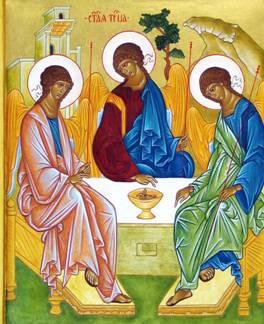 8. Alternate craft idea: Traveling Bag – Take a pillowcase for each child. Thread
8. Alternate craft idea: Traveling Bag – Take a pillowcase for each child. Thread

a piece of clothesline through the open hemmed end to make a drawstring
closure. Dip feet in paint or draw around feet with fabric markers to decorate.
9. Close with prayer.
Isaac
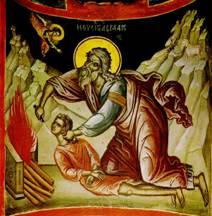 ISAAC
ISAAC
Objectives:
- Children should be able to tell the story of Isaac – his birth, the sacrifice on the mountain, and his marriage.
- Children should identify Isaac as the son of Abraham and Rebekah as his wife.
Possible Lesson Plan:
- Open with prayer.
- Scripture Reference: Genesis 21:1-6, 22:1-18, 24:1-17.
- Learning Game: Try a game of Password. Divide the students into 2 teams. Give one student a name from the story (e.g., Abraham, Sarah, Isaac, Rebekah, servant). That student must give one-word clues to his teammates; have a one-minute time limit and, if the name is not guessed, the other team gets a try. Then the other team gets its own word.
- Draw a family tree: Begin with Abraham and Sarah, add Isaac, then Rebekah. You can draw the children’s family trees as well to illustrate Daddy, Mommy, children.
- Do the children remember the story from the Gospels of the Woman at the Well? Rebekah gave the servant water to drink because he was thirsty. When Christ asked the Canaanite woman for a drink from the well, He told he that He is the Living Water, whoever drinks it will never thirst. So, the water from Rebekah’s well in the Old Testament is just normal water – people drink from it and are thirsty again. But, Christ, the Light of the World, the True and Living Water, gives everlasting nourishment.
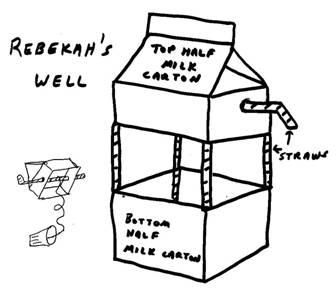 Make Rebekah’s Well: Begin with a milk or whipping cream carton, carefully washed and cut in half. Glue straws in the corners to hold up the roof. Cut holes in the roof for a straw or pipe-cleaner to hold the bucket. Attach a small condiment container or medicine cup to a string. Cover the milk carton with gray paper and decorate it like stones. Alternatively, give each student a lump of clay or play dough. Shape a well by pinching down the inside. Draw bricks on the outside with a plastic knife. Finally, place inside a tealight candle to signify that Christ, the Light of the World, is also the source of Living Water.
Make Rebekah’s Well: Begin with a milk or whipping cream carton, carefully washed and cut in half. Glue straws in the corners to hold up the roof. Cut holes in the roof for a straw or pipe-cleaner to hold the bucket. Attach a small condiment container or medicine cup to a string. Cover the milk carton with gray paper and decorate it like stones. Alternatively, give each student a lump of clay or play dough. Shape a well by pinching down the inside. Draw bricks on the outside with a plastic knife. Finally, place inside a tealight candle to signify that Christ, the Light of the World, is also the source of Living Water. - Alternatively, this age group is old enough to discuss the command, given by God to Abraham, to sacrifice his son, Isaac. Tell the story and print the puppets on the next page on cardstock, cut out, color, and glue popsicle sticks on the back to make puppets. Retell the story with the puppets.
- Close with prayer.
Jacob
 JACOB
JACOB
Objectives:
- Children should be able to identify and name “Abraham, Isaac, and Jacob”.
- Children should be able to tell the stories of Jacob and Esau, Jacob’s ladder, and Jacob and Rachel.
- Children should recognize “Israel” as the name God gave to Jacob, later to be the name of God’s chosen people.
Possible Lesson Plan:
- Open with prayer.
- Scripture Reference: Genesis 25: 21-34, chapters 27-29, 31:1-7, chapter 33.
- Learning Game: Try “The Big Step” – Students begin along the back wall of the classroom. Each is in turn asked a question; if he can answer the question, he gets to take as large a step as he can. If not, he loses that turn. Some questions for this chapter might be:
Who was Isaac’s first-born son?
Who sold his birthright for a pot of stew?
Who received Isaac’s blessing?
How did Jacob deceive Isaac into giving him the blessing?
Who was Rebekah’s brother?
Where did Laban live?
What did Jacob see on the ladder?
Who was Jacob’s first wife?
Who was Jacob’s favorite wife?
- Add Jacob and Esau to your family tree. Then add Leah and Rachel to Jacob.
- Discuss lying and cheating: Did Jacob lie to Isaac to cheat Esau from his inheritance? Was this right? Was Esau happy with Jacob or angry? Have we ever lied? Has anyone ever lied to us or about us? How do we feel? What happened when Jacob returned to the land of Esau? Retell the story of the Prodigal Son: How is this like the return of Jacob to his homeland?
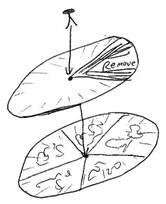
- Make a Story Wheel: Divide a paper
plate into 5 sections. Have each child
draw a picture in each section: Jacob
with Isaac, Jacob and the ladder, Jacob
marrying Rachel, Jacob leaving Laban to go home, Jacob meeting Esau. Take a 2nd
plate and cut out 1 section. Put over the other plate and secure with a brad. Now
tell the stories, one by one, as you turn the
upper plate and reveal the pictures.
- Close with prayer.
Joseph #1
JOSEPH #1
Objectives:
- Children should be able to name Joseph and his brothers as the 12 children of Israel.
- Children should be able to tell the story of Joseph and the many-colored coat and of Joseph sold into slavery.
Possible Lesson Plan:
- Open with prayer.
- Scripture Reference: Genesis 37.
- Learning Game: Try “Brother Concentration”. It may seem unimportant to know the names of all 12 brothers, until one realizes that they become the names of the 12 tribes of Israel. Write each of the 12 names twice on small pieces of paper, or print two copies of the names with their tribal symbols, and tack or tape to the board randomly in rows of 3 by 4. Cover each with a Post-It of similar size and write numbers from 1 to 24 consecutively on the cover papers. The students will guess 2 numbers; if they have the same name behind them, they get to continue. If not, put the Post-It back over the name and keep going.
- Add Joseph and his brothers (Reuben, Simeon, Levi, Naphtali, Issachar, Asher, Dan, Zebulon, Gad, Judah, and Benjamin) to the family tree; Joseph and Benjamin will be under Jacob and Rachel, the rest under Jacob and Leah.
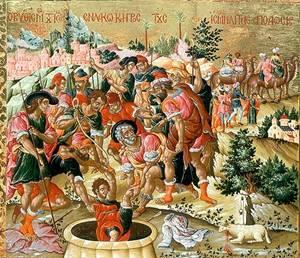
- Make a Many-Colored Shirt: Decorate T-shirts or old long-sleeved men’s shirts (to be painting smocks) with fabric paints or dipping in multiple colors of fabric dye. Mix the fabric dye, Rit or similar, in very hot water according to the directions. Put each color in a separate pail (or other container you don’t mind getting dyed along with the shirts). Let the children dip the shirts in the various dyes to make multi-colored shirts. Try not to overlap the colors too much or the shirts will lose clarity of color.
- Close with prayer
Joseph #2
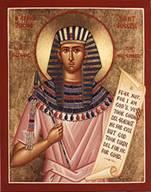 JOSEPH #2
JOSEPH #2
Objectives:
- Children should be able to tell the dreams of the butler, the baker, and Pharaoh.
- Children should know the story of Joseph’s forgiving his brothers.
- Children should know how the people of Israel came to live in the land of Egypt.
Possible Lesson Plan:
- Open with prayer.
- Review the story of Joseph from last week.
- Scripture Reference: Genesis 39-45. There’s too much here, but ever single chapter is important. Have each student read a chapter silently and report on it to the class.
- Learning Game: Try the “Egg Carton Shake” – Take an empty egg carton. In each pocket write the name of an object from the story of Joseph:
grape colored yarn cow ears
basket signet ring scarf coin
caravan sheaf sun cup
Place a small button or coin in the egg carton. Each student in turn shakes the egg carton and has to tell the story of the object where the button landed. If he lands on a story already told, shake again!
- Discussion: Joseph had many things happen to him that were unfair. Can you name some of the times? How did Joseph act in each situation? Have you ever been treated unfairly? Do you try to get revenge or do you forgive as Joseph did? God turned something that was intended for evil toward Joseph into something that was good. Has God ever taken something that was intended for evil against you and made something good out of it? Joseph always worked hard and did his best to honor God. As a result, God blessed Joseph. How can you honor God?
- Make a Signet Ring: Take a piece of
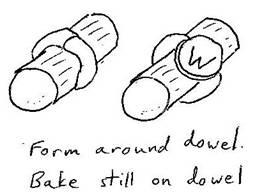 oven-hardening clay (like Sculpey). Form a long snake and a flattened circle and put together as a ring. Inscribe with child’s name or a symbol. Put them in the oven as per directions on the package. While baking,take some beeswax (Father has old
oven-hardening clay (like Sculpey). Form a long snake and a flattened circle and put together as a ring. Inscribe with child’s name or a symbol. Put them in the oven as per directions on the package. While baking,take some beeswax (Father has old
candles.) and melt it on the hotplate. Write a friendly card to a prisoner.
Use wax and ring to seal the card. Send
to the Orthodox Prison Ministry. Keep the
ring to use at home for cards and letters.
- Too time-consuming? Make Joseph’s Egyptian collar, and perhaps a bracelet also, from paper plate, and cup. Cut to fit the child and decorate with markers, sequins, jewels, glitter glue, or even macaroni painted ahead of time for mosaic work.
- Close with prayer.
Moses #1
MOSES #1
Objectives:
- Children should be able to tell the story of the baby Moses and his salvation on the Nile.
- Children should be able to tell the story of the burning bush.
Possible Lesson Plan:
- Open with prayer.
- Scripture Reference: Exodus 2:1-4:20.
- Learning Game: Simon says “It’s True” – Line the students against the wall. As you read them a series of True or False statements, the students respond to your questions physically, as in:
If Pharaoh made a law that all newborn Hebrew boys must die, sit down.
If the soldiers killed Jochebed’s baby boy, scratch your head.
If Jochebed hid her son in a basket, touch your ear.
If Pharaoh’s daughter found the basket, touch your toes.
If Pharaoh’s daughter nursed Moses, stick out your tongue.
If Pharaoh’s daughter adopted Moses, put your elbow on your knee.
If Moses killed an Egyptian overseer, cover your eyes.
If Pharaoh did not want to punish Moses, kneel.
If Moses fled to the land of Midian, stand on one foot.
If Moses never married, put both hands on your nose.
If God spoke to Moses on Mt. Horeb, kneel.
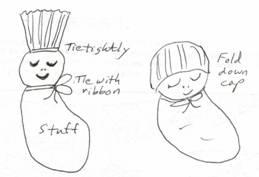 Discussion: It took great courage for Jochebed to give up her son. What might have happened if she had refused? God asked Moses to take His people out of Egypt; Moses know this would be a hard thing to do. Has God ever asked you to do something you felt was hard? Moses was afraid to go to Pharaoh. What makes you afraid? Did Moses run away and hide in fear? What do you do when you are afraid?
Discussion: It took great courage for Jochebed to give up her son. What might have happened if she had refused? God asked Moses to take His people out of Egypt; Moses know this would be a hard thing to do. Has God ever asked you to do something you felt was hard? Moses was afraid to go to Pharaoh. What makes you afraid? Did Moses run away and hide in fear? What do you do when you are afraid?
- Baby Moses Craft: Use one infant sock for each child. Stuff with foam stuffing and tie around neck with ribbon and top of head tightly with string or yarn. Draw or embroider face and fold down cap. Use berry basket, chipwood basket, or make a basket from a piece of cardstock, cut on solid lines and folded on dotted lines and taped at the ends. Color outside to look like a basket. Put a bit of cloth, straw, or tissue paper inside the basket, and lay baby Moses in his basket to travel to Pharaoh’s daughter. Too hard? Take a coffee filter for Moses, with cotton ball inside head, tie with rubber band or pipe cleaner around the neck and take a toilet paper tube cut lengthwise for the basket. Decorate the TP tube with masking tape to look like a basket and use the other half as the cover on the basket.
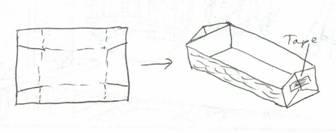
- Close with prayer.
Moses #2
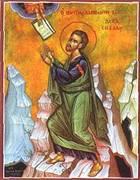 MOSES #2
MOSES #2
Objectives:
- Children should learn the 10 plagues.
- Children should memorize the 10 commandments.
- Children should be able to name Moses as the writer of the books of the Torah, the first 5 books of the Old Testament, and to name the books.
Possible Lesson Plan:
- Open with prayer.
- Scripture Reference: How about Exodus through Deuteronomy? Overwhelming? Have the students read these passages in this order:
Exodus 5:1,2,7,8 Exodus 9:10-12 Exodus 14:10-16
Exodus 7:10-12 Exodus 9:22-24 Exodus 16:13-15
Exodus 7:20-21 Exodus 10:13-15 Exodus 20:1-18
Exodus 8:1-3 Exodus 10:21-23 Exodus 24:15-18
Exodus 8:21-23 Exodus 12: 21-23 Exodus 32:15-21
Exodus 9:2-5 Exodus 12:29-32 Exodus 34:1
3. Learning Game: Name the Order. Write these events on cards and see if the students can put them in order:
Moses found by Pharaoh’s sister Egyptian beating Hebrew
Moses cast out of Egypt Moses at Jethro’s well in Midian
Moses married Zipporah The burning bush
I am Who I Am Bricks without straw
Nile into blood Frogs
Gnats Insects
Cattle disease Boils and sores
Hail like fire Locusts
Darkness over the land Passover
Parting of the Red Sea Death of Pharaoh’s army
Manna Mt. Sinai
10 Commandments Golden Calf
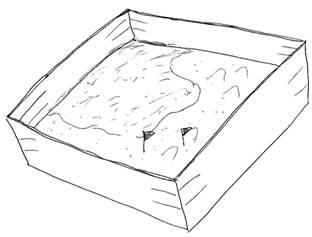
Learning Game for a more active class? Moses Scavenger Hunt: Divide class into teams and give each time a bag. Find each object and identify its role in the story of Moses.
Sword
Basket
Water
Wool
Leaf
Sandal
Pole
Snake
Ice
Water
Sand
Matzoh
Feather
Gold
Stone
Gem
40 somethings
Grape
4. Make a map of the Exodus. Begin with a pizza box for each child (Pizza places will give these to you if you ask.) You can also use a large sturdy paper plate. Mix up enough salt dough for the class with 2 cups of flour for each cup of salt. Add water until play-dough consistency and food coloring – yellow for land and blue for water. Draw or glue a map of Egypt and Palestine on the inside bottom of the box. Sculpt the scenery with land and sea dough. Add flags for special places.
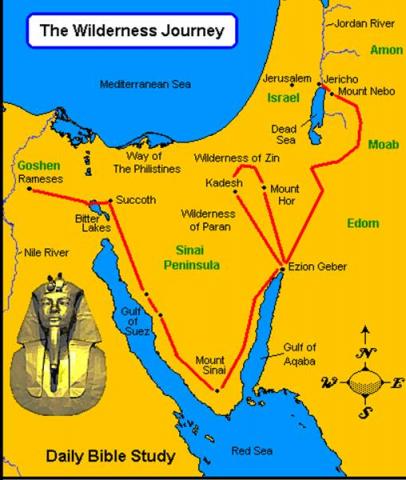
Way too messy? Print the figures on cardstock, cut out, color, and glue or tape popsicle stick on the back to make popsicle puppets. Use to retell the story. For added fun, print the scenery on cardstock, color, fold between each of the 3 sections, and it will stand up behind your puppets.
5. Close with prayer.
Balaam
 BALAAM
BALAAM
Objectives:
- Children should be able to tell the story of Balaam and the donkey.
- Children should understand the importance of obedience to God.
Possible Lesson Plan:
- Open with prayer.
- Scripture Reference: Numbers 22-24.
- Learning Game: Who Am I? Divide into 2 teams. The teacher picks a character from the story and begins to give clues, beginning with the hardest. For example, for Balaam, you might give lives near the river, son of Peor, rides a donkey, speaks for God, etc. After each clue, pause a moment to let the teams guess if they can. The first team to guess the identity of the character gets the point.
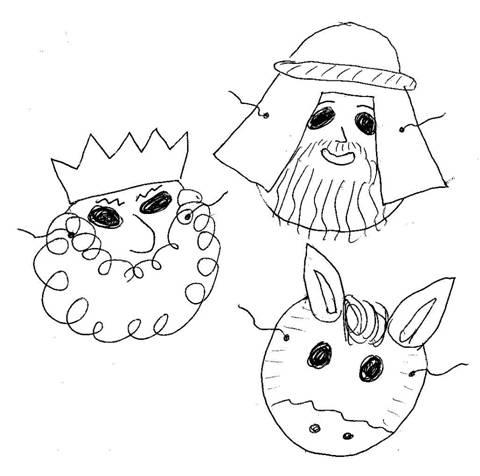
- Have the students make paper-plate masks; assign the roles of Balaam, donkey, angel, Balak, and a bunch of messengers. Each student should make a mask for his character. Cut holes for the eyes and punch small holes for string to go around the head. Beyond that, be creative: yarn, fabric, felt, markers, construction paper, etc. After the masks are finished, tell the story with the students acting out their roles.
- Close with prayer.
Joshua
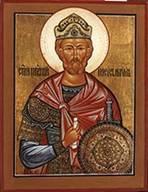 JOSHUA
JOSHUA
Objectives:
- Children should be able to identify Joshua as Moses’s successor.
- Children should be able to tell the story of the battle of Jericho.
- Children should identify Joshua as the person who said, “As for me and my house, we will serve the Lord.”
Possible Lesson Plan:
- Open with prayer.
- Scripture Reference: Joshua 2, 4, 6, 24:15; We have already met Joshua. Where? He was one of the spies sent by Moses to report about the Promised Land. Of the twelve spies, only Joshua and Caleb believed God could give the Israelites this land; the rest were afraid and wanted to turn back to Egypt!
- Learning Game: Relay Race. There are several events that occur in this chapter that can be re-enacted – the escape from Rahab’s roof, the crossing of the Jordan, and the defeat of Jericho. Line the class up in 2 teams. Place a chair about 1/3 of the way to the other side of the room in front of each team. Put a pile of 12 stones at the starting line and a trumpet or noisemaker at the end. Each contestant in turn must grab a stone, climb over Rahab’s wall (the chair), put his stone in the river (next to the trumpet), blow the horn, and run back to tag the next player. The game is over when one team deposits all its stones in the Jordan and the last player returns home.
- Discussion: A well-known verse from the book of Joshua is Joshua 24:15. Here Joshua is speaking for his entire household. If you were speaking for your household, whom would you serve? How can you tell whom Joshua served? How about you?
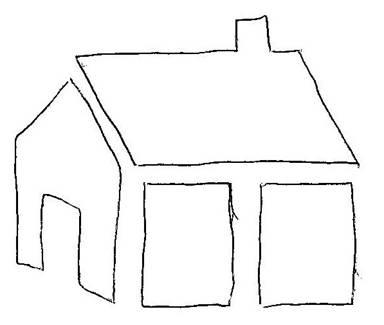
- Make a brick doorstop: Take a clean brick. Cut out the stencil of a house from tagboard or a manila folder. Have each student stencil with acrylic paint a house on the 2 larger sides of the brick. Cut paper to fit one long side and write on it Joshua 24: 15b (“as for me and my house…”). While doing this, review the meaning of the verse. Cut a piece of felt to fit the other long end of the brick. Use as a doorstop.
- Close with prayer.
Judges/Gideon
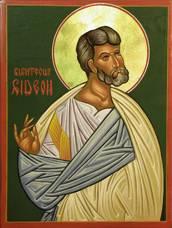 JUDGES/GIDEON
JUDGES/GIDEON
Objectives:
- Children should be able to tell the story of Gideon – the meat offering, the fleece, the choosing of the men, and the battle.
- Children should understand the need to trust in God in all things.
Possible Lesson Plan:
- Open with prayer.
- Scripture Reference: Judges 6-7. When the Israelites entered the Promised Land, they were not ruled by a king but by judges called by God. God had commanded Moses to build the Ark of the Covenant (remember what was in it?) and the Tabernacle – a huge tent, greatly decorated, holding the precious Ark. During the years of wandering, the Levites carried this huge tent and all of its furnishings, to be set up at each new camping place. In the Promised Land, the Tabernacle was set up at a place named Shiloh. The people came to Shiloh to pray and to give offerings to God. On the Day of Atonement each year, the high priest would sacrifice a goat as an offering to the Lord and send another goat out into the wilderness to show that the people’s sins were sent far away. On this holy day, celebrated from the days of Moses until today, the Jewish people fasted and prayed.
- Learning Game:Poses. Choose a pose for each of the 5 events below on your story spinner
- Meat and Cakes: Angel wings flapping
- Destruction of Altar: Horns of bull
- Fleece: Kneel on floor
- Choosing of men: Lap like a dog
- Battle: Blowing horn
Use the sample spinner, or just turn your back and call out an event. On the word “Go” each student assumes one of the 5 poses. You spin and those in that pose are out. Then each much choose a different pose, spin, and finally only one student remains, the winner!
- Discussion: Gideon was one of the judges called by God. How did God call Gideon? What was the purpose of the fleece? How did Gideon choose his men? Why? How did he win the battle? Was Gideon stupid to go into battle with such odds against him? Why or why not?
- Find the tribes of Israel on the map. Where was Gideon. Other judges?
- Make a Story-Spinner:
Take a paper plate. Divide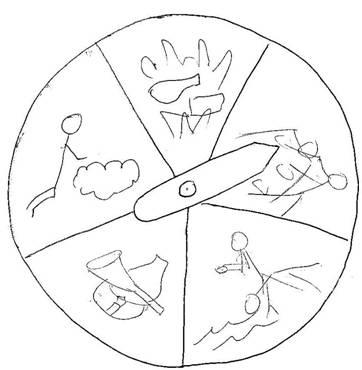
it into 5 sections. In each
section, have the child draw
the stories of Gideon: the
burning of the meat and cakes,
the destruction of Baal’s altar,
the fleece, the choosing of the men, the attack on the
Midianites. Make a spinner out
of tagboard or another plate.
Attach it to the first plate with
a brad; it will spin better with
a small bead between spinner
and plate. Spin the spinner, and
tell the story that goes with the
picture.
- Close with prayer.
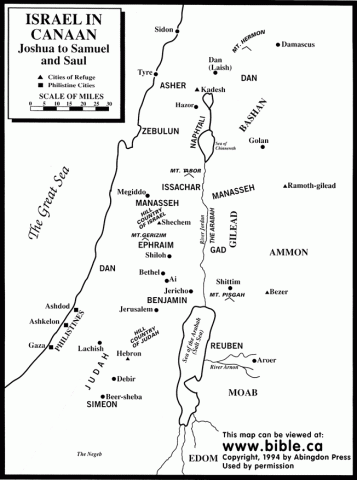
Job
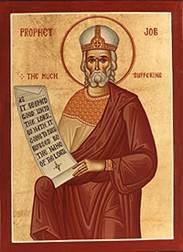 JOB
JOB
Objectives:
- Children should be able to tell the story of Job – his losses and his struggle with Satan.
- Children should know that Job did not curse God.
Possible Lesson Plan:
- Open with prayer.
- Scripture reference: the book of Job. Instead of reading the whole book in class, an impossible task, try a summary reading. Assign the parts of Lord, Satan, Job, Eliphaz, Bildad, Zophar, and Elihu. The teacher can be the narrator. Have the appropriate student read these passages in this order to summarize the book:
Narrator – 1:1-4, 6 Lord – 2:2a Bildad – 18:2-4
Lord – 1:7a Satan – 2:2b Job – 19:1-7, 21-22
Satan – 1:7b Lord – 2:3 Zophar – 20:4-9
Lord – 1:8 Satan – 2:4-5 Job – 27:5-6
Satan – 1:9-11 Lord – 2:6 Narrator – 32:1-6
Lord – 1:12 Narrator – 2:7,11-13 Elihu – 33:8-28
Narrator – 1:13-20 Job – 12:4 Lord – 38:1-12,40:1-2
Job – 1:21 Eliphaz – 15:12-16 Job – 40:3-5
Narrator – 1:22, 2:1 Job – 16:1-3 Lord – 40:7-14
Job – 42:1-6
End with everyone reading Job 42:10-12
- Learning Game: Quotations – Write several well-known quotes from Job (Is there such a thing as a well-known quote?) on index cards. Now tear each card in half and hide one half around the room before class. After reading the Scripture, give each student a card and see if he can find the other half.
Cut out quotes:
Job:1:8 “Have you yet considered my servant Job….
since there is none like him on the earth?”
Job 1: 21 “Naked I came from my mother’s womb, and naked shall I return…
The Lord gave and the Lord has taken away. Blessed be the name of the Lord.”
Job 5:13 “He catches the wise in their craftiness….
and subverts the counsel of the cunning.”
Job 5:17-18 “Blessed is the man whom God corrects…
For He causes a man to be in pain, but He restores him again.”
Job 13:15 “Though the Mighty One should lay His hand upon me….
I will speak and reason before Him.”
Job 13: 26,28 “For You wrote evil things against me and have watched all my works….
which have become old like a wineskin or like a moth-eaten garment.”
Job 17:15-16 “Where then is my hope, or where shall I see my good things?....
Will they go down with me to Hades, or shall we go down together in the tomb?”
Job 19:25 “I know that my Redeemer liveth….
and that He shall stand at the latter day upon the earth.”
Job 24:1-2 “Why have the times escaped the Lord’s notice?,,,
Why have the ungodly stepped over the boundary, snatching away the flock with the shepherd.”
Job 38:4,6 “Where were you when I laid the foundations of the earth?
To what were its foundations fastened, or who laid its cornerstone?”
Job 42: 3 “Who is he who hides counsel from You? …
Who will tell me what I knew not, Things too great and wonderful, which I did not know?”
Job 42: 5 “I have heard of You by the hearing of the ear…
but now my eye sees You.”
- Make a Bible Movie: For each child, take a business-size envelope. Seal it and cut off the ends. Cut a window like a TV screen in the front. Cut a strip of paper wide enough for
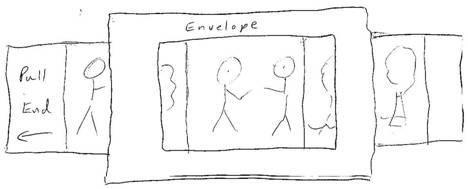 the envelope and about 18 inches long. Divide it into sections like a comic strip, leaving the first and last 3 inches blank. Have the students draw the story of Job like a comic strip in the spaces. Then pull it through the envelope like a movie, telling the story as you go.
the envelope and about 18 inches long. Divide it into sections like a comic strip, leaving the first and last 3 inches blank. Have the students draw the story of Job like a comic strip in the spaces. Then pull it through the envelope like a movie, telling the story as you go.
- Close with prayer.
Ruth
 RUTH
RUTH
Objectives:
- Children should be able to tell the story of Ruth.
- Children should know that Ruth was from the tribe of Moab, not Israel. The Moabites were the descendants of Lot, Abraham’s nephew.
- Children should know that Ruth was a direct ancestor of Jesus.
Possible Lesson Plan:
- Open with prayer.
- Scripture Reference: Ruth 1:3-8, 6-19, 2:1-12, 4:9-11. Remember that the Moabites were the descendants of the son of Lot, the nephew of Abraham.
- Learning Game: Matching Game. Give each student a set of index cards, on which are written the names of the major characters in the story: Ruth, Naomi, Boaz. In the pattern of Final Jeopardy, give a single clue out loud. Each student is to hold up the card of his answer and gets 10 points if right.
- Discuss the customs of marriage – in ancient Israel and today. Why did Ruth stay with Naomi? What is the role of the mother-in-law, then and now? How did Ruth meet Boaz? Why was Ruth in the fields? What custom made Boaz Ruth’s husband? How do we choose a husband today? Who cares for the widow and the elderly today?
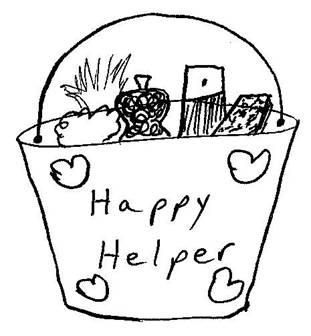
- Ruth was a willing helper.
Make a Happy Helper kit with
each child. Take a bucket (KFC
or a paint store may donate.) Add
a handle of clothesline of there is
no handle. Put in it a dust rag, dish
soap, sponge, window cleaner, paper towels, Fantastic, Pledge, gloves –
whatever you want. Cover the outside
with paper saying “Happy Helper”.
Have each child donate himself to
someone this week. Write a coupon
for service and present it to your
chosen recipient.
- Close with prayer.
Hannah / Samuel
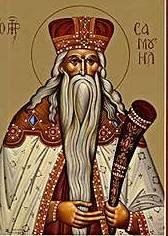 HANNAH/SAMUEL
HANNAH/SAMUEL
Objectives:
- Children should be able to tell the story of Samuel’s birth and his childhood in the temple.
- Children should understand that God spoke to Samuel and called him to his life work, and He will do the same for us.
Possible Lesson Plan:
- Open with prayer.
- Scripture Reference: I Kingdoms/I Samuel 1, 2:18-20, 3 (whole chapter).
- Learning Game: Jeopardy. Make 3 categories: People, Things, Numbers
People: Samuel, Eli, Hannah, Elkanah
Things: Robe, Bull, Ark, Temple
Numbers: Two (sons of Eli), Four (times God called), 12 months (new
robe), Three (how old Samuel was)
Students choose a category and number from 1-4 and have to come up with a question to go with the answer. If they cannot, play passes to the next student.
- Discussion: Discuss other mothers and sons from the Bible: Sarah and Isaac, Rebekah and Jacob. Review their stories. Who else was old and prayed for a son? Do you remember the stories of Anna and baby Mary, Elizabeth and John, and Mary and Jesus from the New Testament? Who else gave her child to be raised in the temple?
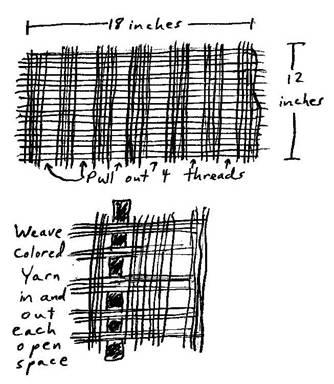
5. Make Samuel’s Mat:
Take a piece of burlap.
Cut a 12x18-inch section
for each child. Along the
long edge, remove 2-3 short
strands several times, spaced
evenly. Now, give the children
colored yarn and have them
weave in and out of the length-
wise remaining fibers. If they
desire, they can remove one or
two strands from each side, making
fringe. This can be a placemat.
Too hard and time-consuming? Take a sheet of construction paper or a large sheet of foam and cut slits about an inch wide going the short direction, leaving about an inch border. Take 1-inch strips lengthwise from a contrasting color and weave thru, making a placemat. If you use paper, cover with clear contact paper to waterproof.
6. Close with prayer.
Saul
SAUL
Objectives:
- Children should be able to identify Saul and the first king of Israel and Samuel who anointed Saul.
- Children should know the story of Saul’s disobedience to God.
Possible Lesson Plan:
- Open with prayer.
- Scripture Reference: I Kingdoms/I Samuel 9:15-10:8, 13:1-15, 15:10-28.
- Learning Game: 20 Questions. Put the names Saul, Jonathon, Samuel, Benjamin, and Philistines in a hat. Have a student draw one. The other students will ask “yes” or “no” questions until they identify the person. Benjamin is included because he was the son of Israel to whose tribe Saul belonged.
- Discuss forms of government: How is our country governed? How was Israel governed in its early years? (with prophets and judges chosen by God for a specific task) Who were some of the people God used to lead His people? (Abraham, Joseph, Moses, Joshua, Gideon, etc.) Review their stories briefly. Why would people want a king? Did other countries have kings? Is it easier to trust a good-looking king or to trust the invisible God? What was Saul’s downfall? Samuel said to Saul, “to obey is better than sacrifice”. What does that phrase mean? Why does God prefer obedience to sacrifice?
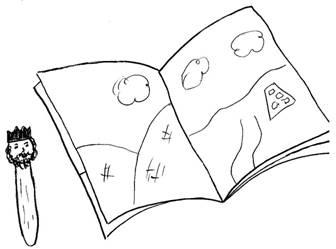 Begin your Book of Kingdoms Storybooks: Take several pieces of heavy paper. Actually, wallpaper is perfect for this and wallpaper stores will often give you old books of samples for free. If not, use construction paper or cardstock. A pale color, light blue or cream (or light-colored wallpaper with a minute pattern) is good for the pages. Punch three holes in each page; and 3 holes in a piece of tagboard for front and back covers. The front cover should have a pocket stapled in for figures. Now, bind your books with yarn or string. OR get folders with 3 fasteners in the middle and pockets. Begin today making figures of Saul and Samuel and mounting with glue on craftsticks as puppets. Draw pictures or color them from coloring books and cut out. Decorate the first 2 pages for the anointing of Saul and his sin against the Lord; what kind of scenery do you need? Grass or flooring can be made of appropriate-colored wallpaper or construction paper glued on the bottom of the page. Other things – trees, chairs, altars, etc. – can be cut out and pasted on. Tell the story, but we’ll add to the book next week.
Begin your Book of Kingdoms Storybooks: Take several pieces of heavy paper. Actually, wallpaper is perfect for this and wallpaper stores will often give you old books of samples for free. If not, use construction paper or cardstock. A pale color, light blue or cream (or light-colored wallpaper with a minute pattern) is good for the pages. Punch three holes in each page; and 3 holes in a piece of tagboard for front and back covers. The front cover should have a pocket stapled in for figures. Now, bind your books with yarn or string. OR get folders with 3 fasteners in the middle and pockets. Begin today making figures of Saul and Samuel and mounting with glue on craftsticks as puppets. Draw pictures or color them from coloring books and cut out. Decorate the first 2 pages for the anointing of Saul and his sin against the Lord; what kind of scenery do you need? Grass or flooring can be made of appropriate-colored wallpaper or construction paper glued on the bottom of the page. Other things – trees, chairs, altars, etc. – can be cut out and pasted on. Tell the story, but we’ll add to the book next week.
- Close with prayer.
David (to Goliath)
DAVID (to Goliath)
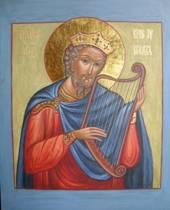 Objectives:
Objectives:
- Children should know the story of David – his anointing, his shepherd childhood, and the story of David and Goliath.
- Children should identify David as the author of many of the Psalms.
- Children should memorize the 23rd Psalm.
Possible Lesson Plan:
- Open with prayer.
- Scripture Reference: I Kingdoms/I Samuel 16-17.
- Learning Game: What’s in the Bag? – Make up ahead of time several lunch bags with items from the story of David in them: a stone, a harp, a sheep, a spear, a piece of bread, some oil, a lion (plastic or stuffed or just a picture). Give each student a bag and have him tell a story about David based on what he finds in his bag.
- Discussion: Do you think David was afraid when he faced Goliath? Goliath is described in the Bible as a descendant of the “giants”. Giants??? There is archeological evidence in Gath (Goliath was from Gath), Monash, and Megiddo of huge weapons and scales from huge body armor. Have you ever been afraid? How did David deal with his fear? You? David proved that it doesn’t matter how old you are, you can do many things with God on your side! Can you think of some things you can do right now to please God?
- Work again on your Book of Samuel Storybooks. This time add David the shepherd boy, the anointing of David, and David and Goliath pages to your book, again with appropriate scenery. Add the figures of David and Goliath, Jesse, and David’s brothers to your collection of figures.
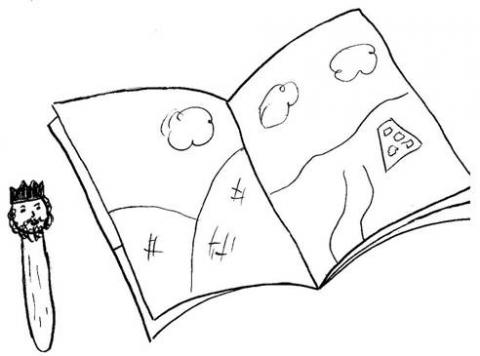
- Close with prayer.
David and Jonathon
DAVID AND JONATHON
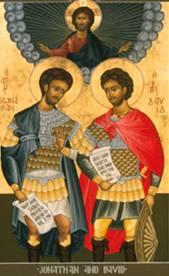
Objectives:
- Children should identify David as King after Saul.
- Children should identify Jonathon as Saul’s son.
- Children should be able to tell the story of David and Jonathon.
Possible Lesson Plan:
- Open with prayer.
- Scripture Reference: I Kingdoms/I Samuel 19:1-10, 20:12-42.
- Learning Game: Look around the Room. Give each student a list of clues. Scatter around the room, cards with the names on them. Each student must hunt for the match for each question and write the answer on his page of clues. Be sure to leave the name cards in place for the next person to find!
Samuel – a boy prophet who grew up to anoint Saul and David
Saul – thought that sacrifice was better than obedience
Jonathon – Saul’s son who became David’s best friend
Jesse – father of David
Eliab – David’s oldest brother
Goliath – Philistine who defied the armies of God
David – carried corn and bread to his brothers on the battlefield
Amalekites – the land and people Saul was to destroy but did not
- Discuss friendship: What is a friend? Who are your friends? What qualities make a good friend? Was Jonathon a good friend to David? Are you a good friend to your friends?
 Now finish your books. Add Jonathon to your figures in the pocket. Add Saul’s tent and the archery field to your pages. Now, can you tell the whole story, from Saul all the way to David and Jonathon?
Now finish your books. Add Jonathon to your figures in the pocket. Add Saul’s tent and the archery field to your pages. Now, can you tell the whole story, from Saul all the way to David and Jonathon?
- Close with prayer.
Solomon
SOLOMON
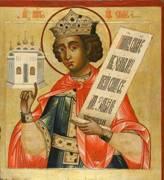 Objectives:
Objectives:
- Students should identify Solomon as David’s son.
- Students should know that Solomon chose wisdom as his gift.
- Students should know that Solomon built the great temple in Jerusalem.
Possible Lesson Plan:
- Open with prayer.
- Scripture Reference: 3 Kingdoms/I Kings 1:32-37, chapter 3.
|
Last week we learned about Samuel picking David to be the king of the Promised Land. |
||
|
David was a good king. |
||
|
He was such a good king that God promised him that someone from his family would always be king. |
||
|
After David grew old and died, his son became the king. |
||
|
His son's name was Solomon. |
||
|
One night when Solomon was asleep, God talked to him in a dream. |
||
|
In his dream God told Solomon He would give him anything he wanted. |
||
|
What would you have asked for if you were Solomon?
|
||
|
Solomon didn't ask for a big palace. |
||
|
He didn't ask for fancy chariots and lots of horses. |
||
|
He didn't ask God to give him lots of gold and jewels. |
||
|
He didn't even ask for God to make him the strongest king. |
||
|
Solomon was afraid he might not be a good king. |
||
|
Many people lived in Solomon’s kingdom. |
||
|
There were so many people that Solomon didn't know how he could be a good ruler to all of them. |
||
|
So Solomon asked God to give him wisdom so he would know how to rule people in the right way. |
||
|
God was happy that Solomon asked Him to make him wise. |
||
|
God said to Solomon, "You could have asked me to give you riches. |
||
|
You could have asked for a long life. |
||
|
But instead you asked for wisdom to help you to be a good king." |
||
|
God was pleased that Solomon asked for wisdom. |
||
|
God told Solomon that because he asked for the right thing, he would make him the wisest king. |
||
|
But God told Solomon that He would also give him what he didn't ask for. |
||
|
He told him He would give him lots of riches and make him the greatest king alive. |
||
|
God also asked Solomon to build Him a great temple in Jerusalem. This temple would have three sections: the outer court, the inner court, and the Holy of Holies. |
||
|
Why were there three sections? Who was allowed in these areas?
|
||
|
God was very pleased that Solomon asked for wisdom because wisdom would make him a better king. |
||
|
God wants us to ask for the kind of things that will make us better people, too. |
Question/Answer:
|
|
What kinds of things do you think we should ask God for that will help us to become better people?
|
||||||||||||
|
|
God is pleased when we ask God for the kinds of things that will make us better people. |
- Try a Word Jumble:
1. God allowed me to build His temple. MONSOLO
2. I am a prophet who gave David and Solomon good advice TANANH
3. I am the father of Adonijah and Solomon. VIDAD
4. I am the city that Solomon lived in. RSLMEJEUA
5. I am the priest who crowned Solomon king of Israel. KOZAD
6. I am what Solomon asked God to give him. SIDMWO
7.Two women brought me before Solomon. YABB
8.We are the people who fought against Israel for many years. LNIEIPIHSTS
- Have each child read a description of the temple in I Kings 6 and 7. Then, with as much accuracy as possible, make a temple out of craft sticks (just like your tower of Babel) or sugar cubes or play dough. Discuss the purpose of the outer court, the inner court and the Holy of Holies. You might even want to make a tiny ark of the covenant from play dough with a tiny 10 commandments to put in the Holy of Holies, with a piece of cloth or felt hanging from a pipe-cleaner or craft stick as a curtain over the door. When dry, the creations can be spray-painted gold, but go lightly with the gold paint if you’re using sugar cubes (They’ll melt!)
6. Close with prayer.
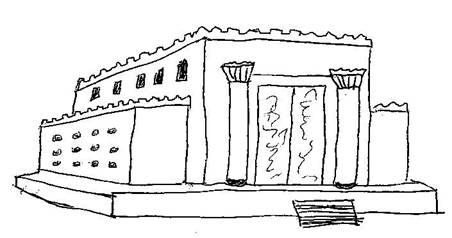
P
Proverbs and Song of Songs
PROVERBS AND SONG OF SONGS
Objectives:
- Children should identify Solomon as the author of these books and also Ecclesiastes.
- Children should identify Proverbs as a book of wise sayings.
- Children should identify Song of Songs as a love poem of Solomon.
Possible Lesson Plan:
- Open with prayer.
- Scripture Reference: Proverbs 30:24-33. These verses talk about the wisdom of the animals and the unique qualities of each. While reading, why not enjoy a snack, perhaps “Ants on a Log” with celery strips spread with peanut butter or cream cheese and then with either raisins or chocolate chips lined up? Have them made in advance, or take just a few minute for the students to make them in class.
- Discussion: What does each of the animals teach us that we can apply to our daily life?
- Ants: Preparation, hard work?
- Rabbits: Protection? Staying safe? Who is OUR rock? (Jesus)
- Locusts: Community, Discipline?
- Lizards: Persistence?
- Lions: Strength?
- Cock: Protection of the hens?
- He-Goat: Leadership?
- Learning Game: Charades – write the name of each animal on a piece of paper. Have students draw one and act it out. The others try to guess which animal it is.
- Craft: Make a Proverbs Teller: Color, cut out, and enjoy. Can they find the other 3 animals on the outside of the “teller” in the chapter?
Proverbs “Teller”
- Cut out the Fortune Teller along the outside line (6 or 8 inch square)
- Color the animals.
- With the printed side up, fold the square in half horizontally and then vertically, open the folds.
- Turn the square over.
- Fold each corner over so they meet in the middle, do not let them overlap.
- Leave the square folded, and flip the square over.
- Now fold the corners into the center – make sure they do not overlap.
- Fold the entire square in half and poke your thumbs and forefingers in under the flaps.
- Bring your fingers together so the Fortune Teller forms a peak –
- YOU are ready to PLAY!
OR
- Make a Proverbs Banner:
Take a 12x18-inch piece of felt.
Fold over one short end around a hanger and staple, or buy some simple banners already made. Have each student choose one of the animals from today’s lesson that speaks to their heart. Draw that animal on paper or on felt, cut out, and glue to the banner. Add rocks, logs, trees, floor of palace, etc., out of felt if desired. Label the banner “Proverbs”.
Alternatively, have each student pick their favorite animal from the verses. Print the animals on cardstock, or let the children draw them on cardstock or construction paper, color, and mount a popsicle stick on the back to make a puppet. Have a short puppet show with each animal showing its unique qualities that we should learn from. Some ideas for the puppets are below, but the children can be creative.
- Close with prayer. Lord, make me as hard-working as the ant, as safe in You as the rabbit, as obedient as the locust, as kingly as the lizard, as strong as the lion, as protective as the rooster and as good a leader as the goat.
Elijah
ELIJAH
Objectives:
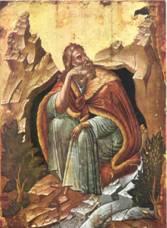 Children should be able to tell the story of Elijah – his feeding by the ravens, the widow of Zarephath, his confronting the prophets of Baal, and the fiery chariot.
Children should be able to tell the story of Elijah – his feeding by the ravens, the widow of Zarephath, his confronting the prophets of Baal, and the fiery chariot.- Children should identify Ahab and Jezebel as an evil king and queen of Israel.
- Children should identify Elijah’s student and disciple, Elisha.
Possible Lesson Plan:
- Open with prayer.
- Scripture Reference: 3 Kingdoms/I Kings 17:1-18:2, 18:17-46, 4 Kingdoms/II Kings 2:1-13. This would be the time to discuss with the children the split among the Jewish people that occurred around 900 BC, dividing the land into Israel in the north with its capital of Samaria and Judah in the south with Jerusalem its capital. Elijah lived in the north and Ahab and Jezebel were king and queen of Israel. At the end of the page, see a synopsis of the kings and prophets of the northern and southern kingdoms for the teacher's reference.
- Learning Game: Egg Carton Jumble – Take an empty egg carton. In each of the pockets, write the name of something from the story. Place a small button or pebble in the egg carton and close it. Let each student in turn shake the egg carton and open it. He must tell the story of the word where the button has landed. Pass to the next student. If the button lands on a word already used, take another turn.
Chariot mantle raven rain bread son
Baal Mt. Carmel fire prophet Ahab altar
- Discussion: Elijah was a prophet of God. What is a prophet? He spoke the words God gave him to say. Many times those words did not make the hearer very pleased. Who else had to say things for God that did not please his audience? (Balaam, Samuel). Review their stories. What are the differences between a prophet of God and a prophet of Baal? Would you have been willing to go to the king if you had been in Elijah’s place? Why or why not?
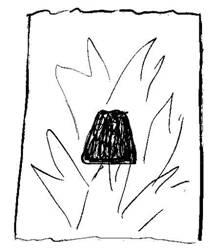
- Make a “Fire from Heaven”
Stained glass window: Give each child a piece of wax paper 18 inches long. Cut out an altar from black construction paper and place in the center of the waxed paper. Cut out flames from yellow, orange, and red tissue paper (in the cabinet) and lay all around and over the altar. They can overlap a little. Take to the teacher. Place another piece of waxed paper over the whole picture, and iron on low to melt the wax. Hang in your window.
No iron, or wax paper too thin nowadays to have enough wax to melt? Use sheets of self-adhesive clear laminating paper. Children can place their altar and flames on the bottom sheet and carefully lower the top one to seal.
- Close with prayer.
KINGS AND PROPHETS: a reference for teachers for a difficult and confusing period in Jewish history
DATES KING OF ISRAEL KING OF JUDAH PROPHETS OTHER KINGS
-----------------------------------------------------------------------------------------------------
933BC Death of Solomon; division into northern and southern kingdoms Ahijah Shishak (Egypt)
933 BC Jeroboam (22 years) – Bad Rehoboam (17 years) – bad Shemaiah
915 BC Abijah (3 years)–bad mostly
912 BC Asa (41 years) – good
911 BC Nadab (2 years) – bad
910 BC Baasha (24 years) – bad
900 BC Rise of Assyria to world power Assur-nasipal II
887 BC Elah (2 years) – bad
886 BC Zimri (7 days) – bad
886 BC Omri (12 years) – horrible
875 BC Ahab (22 years) – the worst Elijah Shalmaneser II
874 BC Jehoshaphat (25 yrs.)–good Ben-hadad (Syria)
855 BC Ahaziah (2 years) – bad Elijah Mesha (Moab)
854 BC Joram (12 years) – bad mostly Elisha Hazael (Syria)
850 BC Jehoram (8 years) – bad
843 BC Jehu (28 years) – bad mostly Ahaziah (1 year) – bad Elisha
843 BC Athaliah (6 years) – horrible
843 BC Joash (40 yrs.)-good mostly Joel
820 BC Jehoahaz (17 years)—bad
806 BC Joash (16 years) – bad
803 BC Amaziah (29yrs)–gd mostly
790 BC Jeroboam II (41 years)-bad Jonah
787 BC Uzziah (52 years) – good Amos
749 BC Jotham (16 years) – good Hosea
748 BC Zechariah (6months) – bad Isaiah
748 BC Shallum (1month) – bad Micah
748 BC Menahem (10 years) – bad
741 BC Ahaz (16 years) – wicked Rezin (Syria)
738 BC Pekahiah (2 years) – bad
748 BC Pekah (20 years) – bad Tilgath-pileser II
730 BC Hoshea (9 years) – bad
721 BC Northern Kingdom Fell. Sargon II
726 BC Hezekiah (29 years) – best Sennacherib
697 BC Manasseh (55 years) –worst Esar-Haddon
641 BC Amon (2 years) – the worst Assur-banipal
639 BC Josiah (31 years) – the best Zephaniah
608 BC Jehoahaz (3 months) – bad Nahum
608 BC Jehoiakim (11 yrs) –wicked Jeremiah Necha II (Egypt)
607 BC Fall of Assyria and Rise of Babylon Habakkuk Nabopolassar
597 BC Jehoiachin (3 months)–bad Nebuchadnezzar
597 BC Zedekiah (11 years) – bad Obadiah
586 BC Fall of Judah.
606-536 The Captivity Daniel Belshazzar
Ezekiel
536 BC Fall of Babylon and Rise of Persia Cyrus (Persia)
536 BC Return from Captivity
Joshua Haggai
Zerubabbel Zechariah Darius I
485 BC Esther Xerxes I
457 BC Ezra Artaxerxes I
444 BC Nehemiah Malachi
Elisha
ELISHA
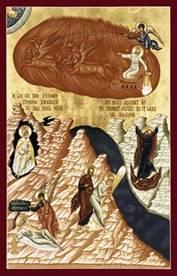 Objectives:
Objectives:
- Children should identify Elisha as the disciple of Elijah.
- Children should be able to tell the stories of Elisha and Naaman.
Possible Lesson Plan:
- Open with prayer.
- Scripture Reference: 4 Kingdoms/II Kings 4:1-36 and chapter 5. We are entering the days of the kings, good and wicked. For over 100 years, Judah,the southern kingdom, enjoyed mostly good kings and prosperity. But, Israel had one wicked king after another until it finally fell to Assyria.
- Learning Game: Let’s try a skit about Naaman – Assign the roles of Naaman, Elisha, King of Syria, little slave girl, Naaman’s wife, and Gehazi. If you want, bring some sheets, towels, scarves, etc., to add a bit of color to the parts.
- Discuss the importance of obedience: God spoke to Naaman through Elisha. Did Naaman want to obey God? Or did Naaman think that what Elisha asked of him was silly? Who else obeyed God, even though it made him look silly? Noah building the ark? Moses holding his staff over the Red Sea? Joshua marching around Jericho? Gideon with his lamp pots and trumpets? David with his sling against Goliath? Do we always understand why we should obey our parents? God? Or do we always ask, “Why?” and miss the miracle.

- Make a Naaman mobile:
Cut six 4x4-inch pieces of cardstock paper For each student. On 2 pieces draw the top half of Naaman. On 1 piece draw the bottom half of Naaman. Color 1 side of each blank piece blue for the Jordan River. Color sores on one top half of Naaman.
Take a 2-foot piece of string for each student. Line up 2 water sections and one head section about one inch apart. Put a line of glue down the center of each piece. Lay the string on the glue. Line up the other head, the body, and the last water piece over the other pieces and glue down.
As the mobile hangs, it will twist and turn, showing Naaman dipping in the wate and being healed.
- Close with prayer.
Jonah
JONAH
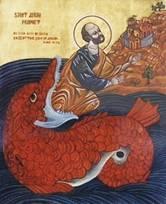 Objectives:
Objectives:
- Children should be able to tell the story of Jonah.
- Children should identify another reason for disobedience – dislike of the command.
Possible Lesson Plan:
- Open with prayer.
- Scripture Reference: Jonah 1-3. Remember that Ninevah was the capital of the Assyrians, who were poised to conquer the entire land of Israel.
- Learning Game: Print the fishy clues and use them to fill in the details of the story:
- Discuss disobedience again: Why did Jonah disobey God? Did he think the command was silly? Did he have trouble hearing God? Or did he dislike the command? Why? Remember that Nineveh was the capital of the Hebrews worst enemy. Did Jonah expect a warm welcome there? Did he have good cause to hate the Assyrians? Are you ever asked to do something you dislike? What? What were the consequences to Jonah for disobedience? What happens to you?
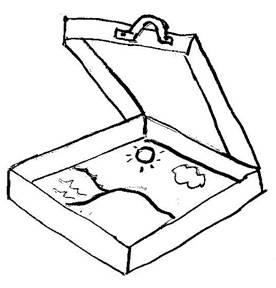
- Make a Port-a-Story Board:
Take a pizza box for each child; pizza places will usually give these to you for free if you ask. Line the inside bottom with light blue felt on the top, tan beach and dark blue sea on the bottom. Cut a large fish, Jonah, sailors, and boat and decorate with markers, yarn, felt clothes, etc. Use like flannelboard to tell the story. Cover the outside of the box with construction paper. Write “The Story of Jonah” on the top. Attach a handle of pipe cleaner or felt to carry the story board.
A bit too much? Try a Jonah “storybook”: Print the fish on cardstock and cut out, cutting in half on dotted line. Now, for most learning, take a long, thin piece of paper and have the students draw the story of Jonah like a comic strip, folding it like a fan between each section. Head of fish is the front cover of the book and tail is the back cover. Takes too much time? Use the comic strip provided for the fan sections, taping together to make one long strip.
Craft is too involved? Try this instead! Take a blue or gray cup for the whale. Add Google eyes and foam tail. Punch a small hole and attach a string. Draw Jonah on a balloon and blow it up just a little. Tie the other end of the string around the neck of the balloon and you have a “ball”-toss game.
- Close with prayer.
Isaiah
ISAIAH
Objectives:
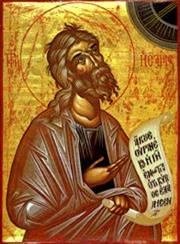 Children should know that a prophet is someone who speaks for God.
Children should know that a prophet is someone who speaks for God.- Children should identify Isaiah as a prophet to the kingdom of Judah, the southern kingdom centered around Jerusalem.
- Children should know the story of Isaiah’s calling.
- Children should know that Isaiah prophesied about the coming of the Messiah.
Possible Lesson Plan:
- Open with prayer.
- Scripture Reference: Isaiah 6, 37:33-38:8, 39. This would be a good time to mention again the split between Israel and Judah and that Isaiah was an advisor to the kings of Judah. During Isaiah’s lifetime, the kingdom of Israel in the north would be captured by the Assyrians and utterly destroyed, but Judah was spared, only to fall later to the Babylonians.
- Learning Game: Hangman. Pass out to each student a card with a word from the chapter on it: Isaiah, Hezekiah, Sennacherib, Assyria, seraphim, coal, etc. Play Hangman with each word.
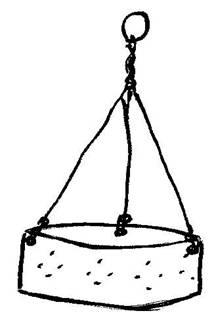
- Discuss the role of a prophet: What are some other ways God can speak to us? What did prophets speak about? (the future, yes, but also advice for the kings of their day and words of warning. Do we have prophets today? Paul talks of prophets in his epistles as an existing ministry. Who might be a prophet today?
- Make a tuna can incense burner. Have a tuna can for each child. Freeze the can full of water and bring to church and place in freezer during Liturgy. Use hammer and nails to produce a pleasing design on the sides. Remove ice. Punch 3 holes along the top rim and cut a length of wire for each. Twist wires to attach to can and to each other to make a hanger. You can actually burn incense and charcoal with this in your icon corner at home.
6. Close with prayer.
Jeremiah
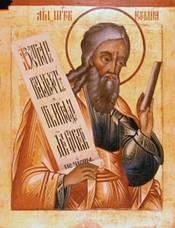 Objectives:
Objectives:
- Children should again identify a prophet as one who speaks for God.
- They should identify Jeremiah as a prophet who lived in Judah.
- Children should identify Jeremiah as author of the book of Jeremiah and of the Lamentations.
- Children should know that Jeremiah prophesied the fall of Jerusalem to the Babylonians and lived to see that fulfilled.
- Children should identify Nebuchadnezzar as King of Babylon.
Possible Lesson Plan:
- Open with prayer.
- Scripture Reference: Jeremiah 13:1-11 and (if there’s time) chapter 28. Jeremiah like Isaiah preached in Judah, the southern kingdom, but later, under the reign of Zedekiah, the last king of Judah. During this time, the Babylonians sacked the temple and took captives; later they returned and leveled the city.
- Learning Game: Out-lister – Give the students each a paper with three headings across the top: Kings, Prophets, Bible Places. Give them 5 minutes to write as long a list as they can for each category. The student with the longest total list is the winner, but he must be ready to identify the entry if questioned about its appropriateness.
- Discussion: What did God say to Judah with the belt (or girdle) demonstration? Was there truth to the statement? How did Jeremiah tell us how to tell a true prophet from a false one? Why was Jerusalem destroyed? Was God “fair” to the Jewish people?
- Make Jeremiah’s Girdle:
 A girdle was actually a belt worn to keep their flowing robes from billowing out too much. Make this one out of felt. Cut a 6x36-inch piece of felt for each student. Punch several holes in each of the short ends. Cut out a 4x4 square of felt also for each student. Staple or glue the “pocket” in the middle of the back of the girdle. Tie yarn in each of the holes as fringe. Alternatively, use a piece of fleece, cut fringe at ends, and make long enough to be a scarf to use at home, as a reminder of Jeremiah.
A girdle was actually a belt worn to keep their flowing robes from billowing out too much. Make this one out of felt. Cut a 6x36-inch piece of felt for each student. Punch several holes in each of the short ends. Cut out a 4x4 square of felt also for each student. Staple or glue the “pocket” in the middle of the back of the girdle. Tie yarn in each of the holes as fringe. Alternatively, use a piece of fleece, cut fringe at ends, and make long enough to be a scarf to use at home, as a reminder of Jeremiah.
- Close with prayer.
Ezekiel
EZEKIEL
Objectives:
-
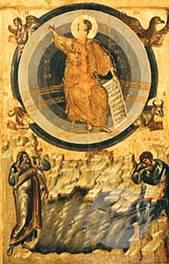 Students should identify Ezekiel as a prophet during the Babylonian captivity.
Students should identify Ezekiel as a prophet during the Babylonian captivity. -
Students should identify Ezekiel as the author of the book of Ezekiel.
-
Students should know at least one of his major visions – the bones.
Possible Lesson Plan:
-
Open with prayer.
-
Scripture Reference: Ezekiel 1:1-28, 3:1-9, 37:1-14. Ezekiel was a contemporary of Jeremiah but was one of the many taken captive by Babylon (along with Daniel and his 3 friends). Initially, Nebuchadnezzar did not destroy Jerusalem or the Temple and left Zedekiah as puppet king. Ezekiel prophesied from Babylon and Jeremiah from Jerusalem, calling the people to repentance. But they would not listen, and 10 years later the Temple of Solomon was destroyed and the city of Jerusalem wrecked.
-
Learning Game: Pictionary. There are 3 major visions here described. Assign each to one student and have the chosen student try to draw the vision for the class to guess.
-
Service Reference: When do we hear the vision of the bones in Church? Every year during Holy Week! Which service? (Holy Saturday matins, usually celebrated Friday evening). Iconic References: In almost any Orthodox Church there is a representation of Ezekiel 1: 10 – “As for the likeness of their faces, each had the face of a man; each of the four had the face of a lion on the right side, each of the four had the face of an ox on the left side, and each of the four had the face of an eagle.” We see here Jesus the man as God incarnate, Jesus the lion for His divinity, Jesus the calf for His sacrifice for our sins, and Jesus the eagle for His resurrection and ascension. And, traditionally, these are each associated with one of the Evangelists – the man for Matthew, the eagle for John, the bull for Luke, and the lion for Mark. So in our own church look again to see the huge ceiling icon and each of the writers of the gospels in the ceiling corner indicated by his symbol.
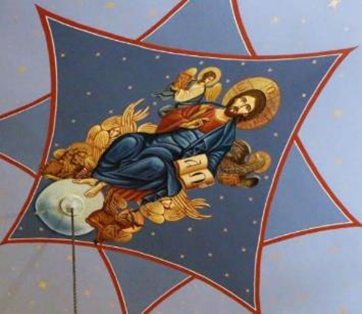
-
Discussion: What is the meaning of the vision of the bones? The wheels? The scroll? Who else in the Scriptures had a vision? (Jacob and his ladder, etc.) Have you ever had a dream? What’s the difference between a vision and a dream? Have you ever had a vision? Do people have visions today anyway?
-
Make an Ezekiel’s Bones Puzzle: Before class, cut the skeleton on the next page out of white paper. Give each child a set of bones in an envelope and a piece of black construction paper. Have him glue the bones into a coherent skeleton on his construction paper. Then cut the entire piece of paper into puzzle pieces. Put the pieces back in the envelope. Have fun!
-
Alternate Craft: Visions of Ezekiel mobile: Take a large paper plate. Enlarge pictures to fit your plate and cut out. Glue wheel to one side, with Ezekiel in the middle. Punch 4 holes around the outside. Attach with strings to each hole the appropriate icon of Gospel writer and his symbol from the four faces glued back to back with the other end of the string in the middle. Use the ones provided, or, even better, pictures of the ones in your own church. If you want, make the skeleton, but attach the bones together with brads and hang in the center below the four faces.
-
Close with prayer.

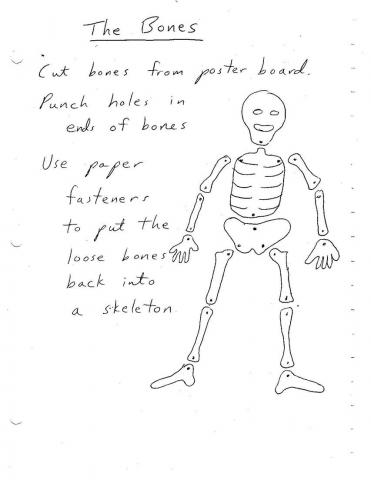
Shadrach, Meshach, and Abednego
SHADRACH, MESHACH, AND ABEDNEGO
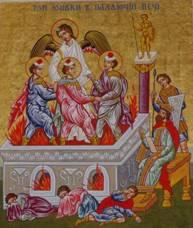 Objectives:
Objectives:
- Children should be able to identify Shadrach, Meshach, and Abednego as the three young men in the fire.
- Children should be able to tell the story of the three young men.
- Children should identify Nebuchadnezzar as King of Babylon and the Jewish people as his prisoners.
Possible Lesson Plan:
- Open with prayer.
- Scripture Reference: Daniel 3. Daniel and his friends, were taken as captives to Nebuchadnezzar’s palace in Babylon. They were given Babylonian names: Daniel became Belteshazzar, Hananiah became Shadrach, Mishael became Meshach, and Azariah became Abednego. I’ve never figured out why Daniel is known by his Jewish name and the others by their Babylonian names!
- Learning Game: The Big Step. Just as before, line up the students at one end of the classroom and the teacher at the other. Ask questions from the lesson. If the student gives the correct answer, he can take a step. If not, take the question to the next student. First to cross the room is the winner.
- Discussion: The story of the 3 young men in the fire is told over and over in the canons around Pascha-time. Why? This story from the Old Testament is thought to be a foreshadowing of the descent of Christ into hell to save the captives. What is a foreshadowing? Who does Nebuchadnezzar represent?
- Make Peanut People:
Take half a peanut for each character: 3 young men, Jesus,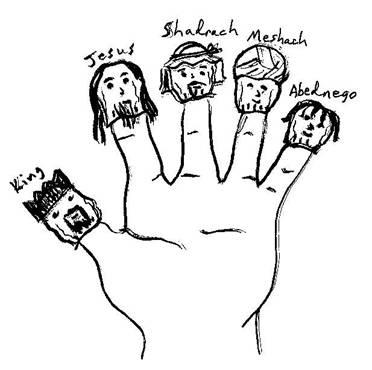 and Nebuchadnezzar. Decorate each peanut half as the person with faces drawn with markers and bits of yarn or fabric or felt for hats, hair, etc. Put a Peanut Person on each finger and tell the story! Someone in the class allergic to peanuts? No problem! Take small strips of paper or cardstock, wrap each into a cylinder the size of a fingertip, and make finger puppets with the same decorations. Or use a glove with each finger a character.
and Nebuchadnezzar. Decorate each peanut half as the person with faces drawn with markers and bits of yarn or fabric or felt for hats, hair, etc. Put a Peanut Person on each finger and tell the story! Someone in the class allergic to peanuts? No problem! Take small strips of paper or cardstock, wrap each into a cylinder the size of a fingertip, and make finger puppets with the same decorations. Or use a glove with each finger a character.
Not into puppets? Try Flame Candle Jar -- Jar candles decorated with tissue paper flames and black cross. Take a clean glass jar with no lid. Cut tissue paper flames of red, orange, and yellow ahead of time, and black regular paper crosses (one cross per student). Who was in the fire with the 3 youths? Glue to outside of jar, paint entire outside of jar with 60/40 glue/water. Just add a tealight!
6. Close with prayer.
Tobit
TOBIT
Objectives:
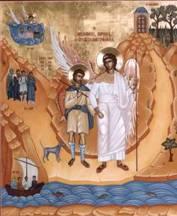 Children should be able to identify the Apocrypha as books that are in the Septuagint Greek Bible but not the Hebrew Bible.
Children should be able to identify the Apocrypha as books that are in the Septuagint Greek Bible but not the Hebrew Bible.- Children should be able to tell the story of Tobit.
Possible Lesson Plan:
During the sad days when the Jewish people were held as slaves by the Assyrians, there lived a man named Tobit. Tobit was a godly man who lived in Galilee and was taken to Assyria as a slave, along with his wife Anna. Tobit and Anna had a son named Tobias. Tobit and Tobias, even though they were captives of the Assyrians, helped their fellow-Hebrews whenever they could. Because of this, the king Esarhaddon did not like Tobit and Tobias and made their lives hard. Finally, Tobit became blind when a bird damages his eyes while he was asleep; he could not see at all. Life seemed hopeless, and Tobit prayed to God that he should die.
At the same time, in Ecbatana, there lived a Hebrew girl named Sarah. She was also praying to God. Seven times she was married; and seven times the demon Asmodaeus killed her new husband on their wedding night.
One day, Tobit sent his son Tobias to Media to collect ten silver coins that he had left there with a friend; they needed the coins to live since Tobit could not work. He hired a man named Azariah as a traveling companion, but Azariah was really the angel Raphael, sent by God to heal both Tobit and Sarah. As they traveled by the river Tigris, Tobias caught a fish. Azariah told him to save the heart, liver, and gall of the fish. Soon Tobias arrived in Ecbatana. There he met Sarah. They were cousins! Tobias fell in love with Sarah and they decided to get married. On their wedding night, Tobias burned the heart and liver of the fish; the awful smell drove the wicked demon away to Egypt. Sarah and Tobias were saved!
Tobias returned home to his father. What rejoicing! He had been gone so long that Tobit had thought he had been killed. Tobias rubbed his father’s eyes with the gall of the fish. Tobit could see again! They thanked God for His faithfulness and goodness in sending the angel Raphael to help them. Tobit then warns Tobias to leave Ninevah because God would soon destroy Assyria for its wickedness. He also promises that God would allow the people of Israel to rebuild the holy Temple in the future.
- Open with prayer.
- Tell the story of Tobit (use highlighted words for the game board):
- Learning Game: Make the game below. Making the game too time-consuming? Use the game provided and play, reviewing the people and places as you land on them. Just print on cardstock. Cut out spinner and add paperclip and brad for the spinning part.
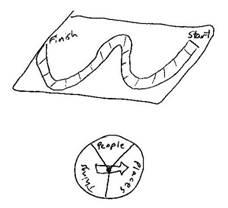
- Discussion: What is the Apocrypha? (books contained in the Greek version of the Old Testament, known as the Septuagint, but not in the Hebrew. Why do some Christians include it in their Bible and some do not?
- Make a game. Draw an S-shaped game path on a piece of poster board. Divide into spaces. On each space, write the name of a character, a place, or a thing from the story. Make a spinner from a small paper plate. Divide it into 3 sections. Label each section “people”, “places”, or “things”. Attach cardboard spinner with brad. When each player spins, he moves to the next space on the board of that category.
- Close with prayer.
Daniel
DANIEL
Objectives:
- Children should identify Daniel as a prophet.
- Children should identify Daniel as the author of the book of Daniel.
- Children should be able to tell the story of Daniel in the lion’s den.
- Children should identify Belshazzar as the last king of Babylon and to tell the story of the handwriting on the wall.
Possible Lesson Plan:
- Open with prayer.
- Scripture Reference: Daniel 5 & 6. Remind the students that Daniel lived during one of the most exciting periods in the history of Mesopotamia (Where’s that?). Babylon, under Nebuchadnezzar, rose to its greatest prominence, with its Hanging Gardens one of the wonders of the ancient world. But, under Belshazzar, his successor, Babylon was conquered by Cyrus of Persia, who marched into the city with his army in the dead of night on the dry bed of the Euphrates River that flowed under the city walls (after damming the river!). Cyrus was succeeded by Darius.
- Learning Game: Divide the class into 2 groups. Each group has 5 minutes to prepare a skit about either “The Handwriting on the Wall” or “Daniel in the Lion’s Den”. Then have each group perform for each other.
- Discussion: God protected and helped Daniel in difficult situations. Which ones? How has God helped and protected you and your family? Daniel was obedient to God. Why is obedience important? What did Samuel say to Saul? Daniel had great faith in God. What does it mean to have faith? Why is faith important? How does obedience show faith? Daniel always put God first in his life. How did he show this? Do you put God first? How do you show it?
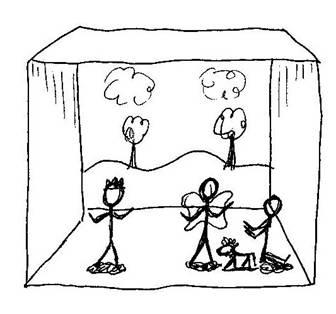
- Make a Diorama:
Begin with a small box like a shoebox for each child. Cut out the front panel. Cut a piece of construction paper to fit the back; color it as scenery and glue in place inside the box. Now make figures for Daniel, Darius, the wicked advisors, and the lions out of pipe cleaners. Use modeling clay as a base to stand the figures and place them in the diorama.
Too much time? Use the pop-up diorama. Print 1 piece of cardstock with the background and color. Cut 3 pieces of cardstock, perhaps light blue but any color, like a frame with 1-inch borders. Take the centers you removed and fold them like fans and glue to short sides, adding one level at a time. Cut out Daniel and Habakkuk from the icon picture and glue on different levels. Color and cut out lions and glue on. Don’t forget to glue the clouds in the sky!
Alternate craft: Watercolor resist -- Focus instead on the handwriting on the wall. Ahead of class, write the words from the handwriting with white crayon on white copy paper. Give the students the "blank" papers. Let them use watercolors to bring out the words, any colors they want. Remind them what the words mean and their significance.
6. Close with prayer.
Esther
ESTHER
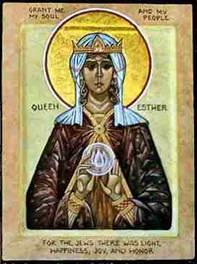 Objectives:
Objectives:
- Children should be able to identify Esther as Queen of Persia.
- Children should be able to identify her husband Ahasuerus and Mordecai and Haman.
- Children should be able to tell the story of Esther.
Possible Lesson Plan:
- Open with prayer.
- Scripture Reference: Esther 5:1-8 and chapter 7. Unless you want to read the entire book, set the scene for the students. Ahasuerus, also known as Xerxes (his Greek name), king of Persia, chose Esther, a Jewish girl living in in Persia, as his queen, after his previous queen, Vashti, refused to obey him. Haman was his chief advisor. Mordecai, Esther’s cousin, has learned that Haman has tricked the king into ordering the death of all the Jews. But, Esther is not supposed to go to her husband, the king, unless he first calls her; the punishment is death! As you read the Scriptures aloud, have the students shake noisemakers and boo every time the villain, Haman, is named. This is exactly the way Purim, the holiday commemorating Esther, is celebrated in a Jewish synagogue to this day.
- Learning Game: Line ‘em up! – Write the events of the story on cards, one for each student. Have the students read their cards aloud and line up in the correct order to tell the story.
- Discussion: Esther was willing to go to the king even if she died for it. This decision took great courage. What decisions have you made that took courage? What do you think might have happened if Esther had been too afraid to go before the king? Mordecai believed that God would take care of Esther. How does God care for us?
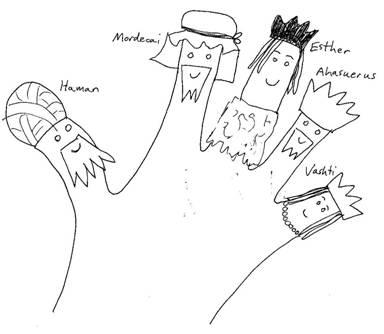
- Make Esther Glove Puppets:
Take a white or beige gardening glove for each child. Decorate each finger with little bits of fabric, lace, felt, beads, and markers to be the major characters of the story: Haman on the thumb, Queen Vashti on the little finger, and Esther, Ahasuerus, and Mordecai on the other fingers. Tell the story, killing first Vashti and then Haman by bending down the fingers. You can decorate the palm as a palace with fabric paint or markers if desired.
Too much crafting for the time allotted? Take the comic strip and print and color. Add front and back cover of construction paper, writing "The Story of Esther" on the front cover. Staple together. Take the book home and read to the family.
- Close with prayer.
Minor Prophets -- Habakkuk
MINOR PROPHETS: HABAKKUK

Objectives:
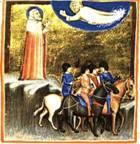 Students should identify Habakkuk as a prophet who prophecies of the coming Messiah, Jesus Christ.
Students should identify Habakkuk as a prophet who prophecies of the coming Messiah, Jesus Christ.- Students should be able to tell of his message to the people of Judah.
- Students should be able to tell the story of Daniel and Habakkuk.
- Students should learn the names of all 12 “minor prophets”.
Possible Lesson Plan:
- Open with prayer.
- Scripture Reference: Habakkuk lived in the land of Judea during the time of the prophets Daniel and Jeremiah. Read Daniel 22:33 -- In the book of Daniel, according to the Septuagint, an angel told Habakkuk to take his stew and bread to Daniel while he was in the lion’s den. Habakkuk was in Judea; Daniel in Babylon. The angel transported Habakkuk to Babylon and provided food for Daniel! The icon on the right pictures Daniel in the lion’s den with Habakkuk and the angel above him and Christ above all. As to the message of the Lord to His people through Habakkuk, Habakkuk saw the terrible evil among his own people and spoke to them of God’s coming judgment at the hands of the Babylonians. The icon on the left pictures Habakkuk’s vision of the Babylonian army in its pride. Who then can we trust? Read Habakkuk’s answer in Habakkuk 3:17-19. Finally, read 2:20 and 3:3 – prophecies of the coming of Jesus 600 years before the Nativity. Habakkuk – a short book with a lot to say!
- Learning Game: Try Concentration with all 12 minor prophets.
- Discussion: How would you like to go down in history as a “minor prophet”? No one knows who you are or what you said and did individually! But these were real people, speaking for the Lord from very different vantage points. Compare and contrast Habakkuk and Jonah (whom you’ve already met). Where were they from? Who were they to speak to? What was the response of each to God’s calling? What was the message? What was the outcome for each?
- Make “Habakkuk’s Stew”: Try making a real stew if you have access to a kitchen. Cut the meat, chop the vegetables, boil and enjoy with bread. OR, take a small plastic cup, silver or black if possible. Poke two holes across from each other near the top and attach a pipe cleaner for a handle. Squirt in a good quantity of glue and add dried beans, barley, dried peas and corn, in a pleasing arrangement. You can purchase a really nice combo of dried beans in the supermarket as 15-bean soup mix. When it dries, spray with clear spray to make the stew pot more permanent. Consider using as a Christmas ornament; Habakkuk’s prophecy is read at Nativity. Add a red bow or a piece of holly for an ornament.
- Close with prayer. Pray that we will respond to God’s call as did Ninevah, and not as did Judah.
Minor Prophets -- Micah
MINOR PROPHETS: MICAH
Objectives:
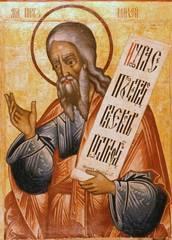 Children should be able to identify Micah as a prophet who spoke for God.
Children should be able to identify Micah as a prophet who spoke for God.- Children should know that Micah lived in Judah, the southern kingdom.
- Children should know that Micah prophesied the birth of Jesus in Bethlehem.
- The main thrust of Micah’s message was the destruction of Samaria and Jerusalem.
Possible Lesson Plan:
- Open with prayer.
- Scripture Reference: Micah 1:1-12, Micah 6:8 and Micah 5:2-4. Micah lived near Jerusalem, a contemporary of Isaiah, but correctly prophesied the destruction of Jerusalem 100 years later.
- Learning Game: Quotations – Take a well-known quotation from each of the “minor prophets” (yes, there are well-known quotations, you just may not know where they’re from!) and write each on an index card. Tear the cards in half and give one half of each quote to each student and hide the other around the room. Students must find their missing half. Now read all aloud. Some suggestions would be:
Hosea 11:1 Obadiah 4 Nahum 1:3a Haggai 2:9
Joel 3:10 Jonah 2:1 Habakkuk 3:19 Zechariah 9:9
Amos 3:7 Micah 6:8 Zephaniah 1:7a Malachi 3:1a
To review? Make a "Prophet Catcher":
Prophet Catcher
- With the printed side up, fold the square in half horizontally and then vertically, open the folds.
- Turn the square over.
- Fold each corner over so they meet in the middle, do not let them overlap.
- Leave the square folded, and flip the square over.
- Now fold the corners into the center – make sure they do not overlap.
- Fold the entire square in half and poke your thumbs and forefingers in under the flaps.
- Bring your fingers together so the Fortune Teller forms a peak –
- YOU are ready to PLAY!
Amos, the shepherd, Habakkuk with his pot of stew for the Prophet Daniel, Micah and his prophecy of the city of Bethlehem, and Haggai with the rebuilding of the temple in Jerusalem are on the 4 outside flaps. Can the students correctly identify the prophets associated with the quotes beside the numbers?
- Review the prophecies about the Christ: Isaiah? (born of a virgin, a Nazarene, suffering and death); Micah? (born in Bethlehem); Jeremiah? (the slaying of all children under two); Zechariah? (riding on a donkey), Malachi (John the Baptist). These prophecies are scattered all over the Old Testament, yet Jesus fulfilled them all!
- Make a “Kindness Jar”:
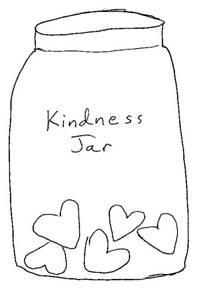
Read Micah 6:8: What does God want of us? “Mercy” is similar to kindness. Have eachchild write on small red paper hearts several acts of kindness that he or she could perform – for parents, for friends, for school, for the church. For example, “Tidy my room”, “Empty the trash”, “Pick up used candles”, etc. Cover a jar or can with a piece of construction paper. Write on it “Kindness Jar” and decorate it with hearts, flowers, etc. Take the jar home and remove a heart each day and do what it says.
- Close with prayer.
Ezra and Nehemiah
EZRA/NEHEMIAH
Objectives:
- Children should be able to identify Ezra as the priest who brought the law back to Jerusalem.
- Children should identify Nehemiah as the Jewish governor who rebuilt the city wall.
- Children should identify Cyrus and Darius as the kings of Persia who allowed the work.
Possible Lesson Plan:
- Open with prayer.
- Scripture Reference: Nehemiah 2:1-6, 4:6-23, 8:1-9.
- Learning Game: Try 20 Questions: Write the names of Ezra, Nehemiah, Artaxerxes on slips of paper. Let a student choose a name; the others have 20 questions (“yes” or “no” only) to guess the identity of the person. Then move on to the next name.
- Discussion: This is a good time to review this very difficult period in Jewish history. Remind the children of the line of kings from Saul to David to Solomon and the glory of the temple in Jerusalem. Review the split of the people into the northern kingdom, Israel, with its capital in Samaria and the southern kingdom, Judah, with its capital in Jerusalem. With older children, you can make comparisons with our own Civil War. God was not happy! He sent prophets to both kingdoms – Elijah and Elisha to Israel and Isaiah, Amos, Micah, and Jeremiah to Judah. Which prophet was sent to the Assyrians? (Jonah) Review the fall of Israel to the Assyrians and of Judah to the Babylonians. Who was the king of Babylon? (Nebuchadnezzar). Who were some of the prisoners taken back to Babylon? (Shadrach, Meshach, Abednego, Daniel, Ezekiel) Review their stories from captivity. Now Nebuchadnezzar’s heir Belshazzar has fallen to Cyrus of Persia (He sneaked into Babylon in the bed of the river). People began returning to Palestine from Babylon in the days of Cyrus of Persia under the Jewish governor Jerubbabel. But work on the city bogged down due to opposition from their neighbors and did not resume for 15 years during the reign of Darius. Now, with the blessing of Artaxerxes, Ezra is sent to re-institute the law and Nehemiah to rebuild the wall, each with the blessing of Persia. Haggai and Zechariah preached during the early work and Malachi during the time of Nehemiah.
- Make “Ezra’s Scroll of the Law”: Take a piece of brown wrapping paper. Write on it the 10 Commandments. Roll into a scroll and tie with a ribbon. Review the Commandments to be sure they’re still memorized.
- Close with prayer.
Maccabees
MACCABEES
Objectives:
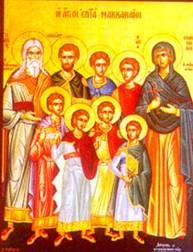 Students should be able to identify Judah Maccabee as the hero and Antiochus as the wicked king.
Students should be able to identify Judah Maccabee as the hero and Antiochus as the wicked king.- Students should know that the story of Maccabees is the basis for the Jewish feast of Hanukkah.
- Students should understand the meaning behind the 8 candles of the Hanukkah menorah and the one to use to light the others.
Possible Lesson Plan:
- Open with prayer.
- Tell the story of Judah Maccabee and his brothers:
Church School will start a bit late today, because I’ll use my tape, “The Story of Hanukkah” to tell the story for everyone during opening exercises.
No tape? Tell the story of Judah Maccabee and Hanukkah: About 2200 years ago, Greek kings, who reigned from Damascus, ruled over the land of Judea and the Jews living there. One Greco-Syrian King, Antiochus Epiphanes, forbade the Jewish people from praying to their God, practicing their customs, and studying their Torah. Antiochus forced the Jews to worship the Greek gods. It is said that he placed an idol of the Greek God Zeus on the alter in the Holy Temple of Jerusalem. In response to this persecution, Judah Maccabee and his four brothers organized a group of resistance fighters known as the Maccabees. They fought against paganism and oppression. Against great odds, after three years of fighting, the Maccabees succeeded to drive the Greco-Syrians out of Judea. Hanukkah proclaims the message of the prophet Zachariah: "Not by might, not by power, but by My spirit." The Maccabees reclaimed the Holy Temple in Jerusalem. They cleaned the Temple, removing the Greek symbols and statues. When Judah and his followers finished cleaning the temple, they rededicated it. According to tradition, when the Maccabees entered the Holy Temple, they discovered that the Greco-Syrians had defiled the oil which was used in the Temple's menorah. Only one jar of purified oil remained, enough for only one day. It would take the Jews a week to process more purified oil. Then, a miracle occurred. The Maccabees lit the menoriah and it burned for not one, but eight days, by which time the new, purified oil was ready. This is wh the Hanukkah Menorah has eight candles (not including the shamash candle in the center used to light the others) and one reason why Jews celebrate Hanukkah for eight days.
3. Service References: We sing to the Maccabees and their courage as equal to the martyrs in this Kontakion:
O, ye seven pillars of the wisdom of God,
Seven-branched lamp of the light divine.
O, most-wise Maccabees, who before the martyrs
Were martyrs most great.
With them entreat ye the God of all
That we who honor you may be saved! 4. Play with a dreidl: You can get one of these at any party store. Each letter has a meaning. Each child starts with about 20 raisins. Each puts one raisin in the center of the table. They take turns spinning the dreidl. If it lands on Nun, they get nothing. If it lands on Shin, they have to give a raisin to each player. If it lands on Heh, they get half of the raisins in the center. And if it lands on Gimel, they get all the raisins in the center and everyone puts one raisin back into the center. When you decide time is up, the child with the most raisins is the winner, and each gets to eat his raisins.
5. Discussion: Hanukkah is celebrated in late December and is often referred to as the “Jewish Christmas”. Does Hanukkah have anything to do with the birth of Jesus? Whose story is told? We left Jewish history with the return from Babylon under the Persians. But the Persians were ousted by the Greeks under the Macedonian king Alexander the Great. Alexander’s empire collapsed with his death, but the Greek influence continued in Palestine under a whole dynasty of kings, all with the same name! What was it? (Antiochus). It was Antiochus IV with whom the Maccabees had problems. What miracle occurred? How many days did the lamp in the great menorah burn? Why are there nine candles on the Hanukkah menorah? (one to light the others with) 6. Make your own menorah: Take an aluminum foil pie pan. Fold in half and flatten the top a bit to poke holes for the candles using a skewer or a pencil tip. Insert real candles. Hanukkah candles are typically colorful and very cheap to buy, but birthday candles or even small beeswax candles from your candlestand will be fine. Use two toilet paper tubes for a base, cutting a deep slit to insert the double edge of the pie pan. If you want, wrap the tubes in duct tape to make them prettier. Decorate with stickers or glitter glue.
Lots of boys in the class interested in the battles? The Maccabees fought against an army with hundreds of ELEPHANTS and defeated the enemy. Make a toilet paper tube war elephant and Judah Maccabee. Print elephant and Judah patterns on cardstock and cut out. Make the elephant with 2 ears, wiggle eyes, and trunk glued to one TP tube. Now add the facial armor and cut a slit in the top of the TP tube to insert the armored tower with the soldiers behind the head of the elephant. If you want, don’t print the spears of the soldiers at all, but use bamboo kabob skewers to poke holes and become the spears. Glue the image of Judah onto the other TP tube. Read the book of I Maccabees to hear the story of the battles.
7. Close with prayer.